State Bar of New Mexico
License Renewal and MCLE Compliance



























Est. 1886
Est. 1886
Officers, Board of Bar Commissioners
Erinna M. "Erin" Atkins, President
Aja N. Brooks, President-Elect
Allison H. Block-Chavez, Secretary-Treasurer
Benjamin I. Sherman, Immediate Past President
State Bar Staff
Executive Director, Richard Spinello
Marketing Communications Manager, Celeste Valencia, celeste.valencia@sbnm.org
Graphic Designer, Julie Sandoval, julie.sandoval@sbnm.org
Advertising and Sales Manager,
Marcia C. Ulibarri, 505-797-6058, marcia.ulibarri@sbnm.org
Assistant Communications Manager, Brandon McIntyre, brandon.mcintyre@sbnm.org
©2024, State Bar of New Mexico. No part of this publication may be reprinted or otherwise reproduced without the publisher’s written permission. The Bar Bulletin has the authority to edit letters and materials submitted for publication. Publishing and editorial decisions are based on the quality of writing, the timeliness of the article, and the potential interest to readers. Appearance of an article, editorial, feature, column, advertisement or photograph in the Bar Bulletin does not constitute an endorsement by the Bar Bulletin or the State Bar of New Mexico. The views expressed are those of the authors, who are solely responsible for the accuracy of their citations and quotations. State Bar members receive the Bar Bulletin as part of their annual licensing fees. The Bar Bulletin is available at the subscription rate of $125 per year and is available online at www.sbnm.org.
The Bar Bulletin (ISSN 1062-6611) is distributed twice a month by the State Bar of New Mexico, 5121 Masthead St. NE, Albuquerque, NM 87109-4367. The first issue of each month is published and distributed in print and electronically. The second issue of each month is distributed electronically. Periodicals postage paid at Albuquerque, NM. Postmaster: Send address changes to Bar Bulletin, PO Box 92860, Albuquerque, NM 87199-2860.
505-797-6000 • 800-876-6227
Fax: 505-828-3765 • address@sbnm.org
November 13, 2024 • Volume 63, No. 11
www.sbnm.org

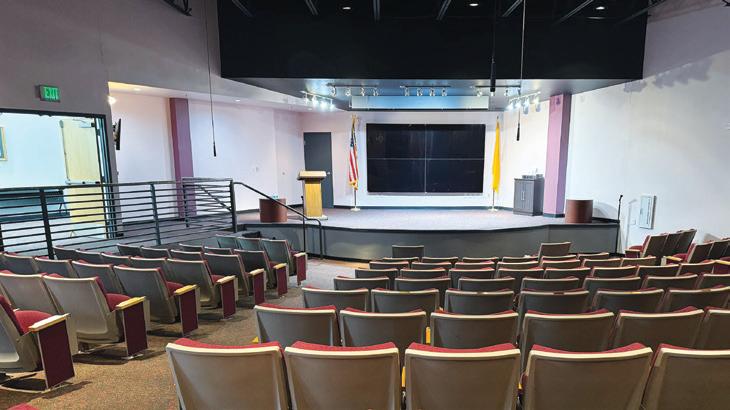
Perfect for your conference, seminar, training, mediation, reception, networking event or meeting.
• Multi-media auditorium with seating to accommodate 160 people
• 3 spacious classrooms (equipped with removable walls to make a larger space)
• Small and large conference rooms with capacity from 6 to 12 people
• 2 multi-media boardrooms
• Ample parking
• Free Wi-Fi
• Snack and beverage service
• Hybrid meeting capabilities in most rooms
Est. 1886
5121 Masthead St. NE, Albuquerque, NM 87109 www.sbnm.org/StateBarCenter
For more information, site visits and reservations, contact Guest Services at 505-797-6070 or roomrental@sbnm.org

Please email notices desired for publication to notices@sbnm.org.
To view recent Supreme Court rulemaking activity, visit the Court's website at https://supremecourt.nmcourts.gov. To view all New Mexico Rules Annotated, visit New Mexico OneSource at https:// nmonesource.com/nmos/en/nav_date.do.
The Supreme Court Law Library is open to the legal community and public at large. The Library has an extensive legal research collection of print and online resources. The Law Library is located in the Supreme Court Building at 237 Don Gaspar in Santa Fe. Building hours: Monday-Friday 8 a.m.-5 p.m. (MT). Library Hours: Monday-Friday 8 a.m.-noon and 1-5 p.m. (MT). For more information call: 505-827-4850, email: libref@nmcourts.gov or visit https://lawlibrary.nmcourts.gov.
Learn About Access to Justice in New Mexico in the "Justice for All" Newsletter
Learn what's happening in New Mexico's world of access to justice and how you can participate by reading "Justice for All," the New Mexico Commission on Access to Justice's monthly newsletter! Email atj@ nmcourts.gov to receive "Justice for All" via email or view a copy at https://accesstojustice.nmcourts.gov.
The State Bar of New Mexico Board of Bar Commissioners has completed its budgeting process and finalized the 2025 Budget Disclosure, pursuant to the State Bar Bylaws, Article VII, Section 7.2, Budget Procedures. Starting Nov. 1, the budget disclosure will be available in its entirety on the State Bar website at www.sbnm.org on the financial information page under the About Us tab. The deadline for submitting a budget challenge is on or before noon (MT), Dec. 2, and the form is provided on the last page of the disclosure document. The BBC will consider
With respect to opposing parties and their counsel: I will consult with opposing counsel before scheduling depositions and meetings or before rescheduling hearings.
any challenges received by the deadline at its Dec. 11 meeting. Address challenges to: Executive Director Richard Spinello, State Bar of New Mexico, PO Box 92860, Albuquerque, N.M. 87199; or info@sbnm.org. Challenges may also be delivered in person to the State Bar Center, 5121 Masthead NE, Albuquerque, N.M. 87109.
State Bar of New Mexico annual license renewal and Minimum Continuing Legal Education requirements are due Feb. 3, 2025. For more information, visit www. sbnm.org/compliance. To complete your annual license renewal and verify your MCLE compliance, visit www.sbnm. org and click "My Dashboard" in the top right corner. For questions about license renewal and MCLE compliance, email license@sbnm.org. For technical assistance accessing your account, email techsupport@sbnm.org.
The Board of Bar Commissioners will make one appointment to the NM Access to Justice Commission for a three-year term. The Commission is dedicated to expanding and improving civil legal assistance by increasing pro bono and other support to indigent people in New Mexico. For more information about the Commission, visit https://accesstojustice.nmcourts.gov/. Active status attorneys in New Mexico who would like to serve on the Commission should send a letter of interest and brief resume by Nov. 22 to bbc@sbnm.org.
The Board of Bar Commissioners of the State Bar of New Mexico will appoint one director to the New Mexico State Bar Foundation Board for a three-year term. The New Mexico State Bar Foundation's mission is to advance the legal community’s commitment to serve the legal profession and people of New Mexico. Through member donations, fundraising and programs, the Foundation provides and promotes
access to legal services to underserved New Mexicans. The Foundation also supports public service, education, and diversity, as well as organizations consistent with its mission. For more information about the Bar Foundation, visit https://www. sbnm.org/Bar-Foundation. Active status members interested in serving on the Board should submit a letter of interest and resume to bbc@sbnm.org by Nov. 22.
The Monday Night Attorney Support Group meets at 5:30 p.m. (MT) on Mondays by Zoom. This group will be meeting every Monday night via Zoom. The intention of this support group is the sharing of anything you are feeling, trying to manage or struggling with. It is intended as a way to connect with colleagues, to know you are not in this alone and feel a sense of belonging. We laugh, we cry, we BE together. Join the meeting via Zoom at https://bit.ly/attorneysupportgroup.
The N.M. Well-Being Committee was established in 2020 by the State Bar of New Mexico's Board of Bar Commissioners. The N.M. Well-Being Committee is a standing committee of key stakeholders that encompass different areas of the legal community and cover state-wide locations. All members have a well-being focus and concern with respect to the N.M. legal community. It is this committee’s goal to examine and create initiatives centered on wellness. The WellBeing Committee will hold its final meeting this year at 3 p.m. (MT) on Nov 26. Email Tenessa Eakins at Tenessa.Eakins@sbnm.org.

Your Fastcase member benefit as a State Bar of New Mexico licensee will transition to vLex Fastcase on Nov. 19. This improved legal research platform includes all the materials you currently access on Fastcase, plus new features designed specifically for attorneys. To help you make the most of this powerful new tool, we invite you to join an upcoming livecast webinar on Dec. 5 at 10 a.m. (MT). Register for the livecast webinar at https://attendee.gotowebinar.com/register/72288748796795 10619?source=Bar+Website. During this webinar, vLex Fastcase will demonstrate the new features of the platform and show you how to maximize its potential for your legal practice.
Presented by the New Mexico Lawyer Assistance Program, the Solutions Group, the State Bar’s Employee Assistance Program (EAP), extends its supportive reach by offering up to four complimentary counseling sessions per issue, per year, to address any mental or behavioral health challenges to all SBNM members and their direct family members. These counseling sessions are conducted by licensed and experienced therapists. In addition to this valuable service, the EAP also provides a range of other services, such as stress management education, webinars, critical incident stress debriefing, video counseling, and a 24/7 call center. The network of service providers is spread across the state, ensuring accessibility. When reaching out, please make sure to identify yourself with the NM LAP for seamless access to the EAP's array of services. Rest assured, all communications are treated with the utmost confidentiality. Contact 505254-3555 to access your resources today.
The New Mexico State Bar Foundation and its partner legal organizations gratefully welcome attorneys and paralegals to volunteer to provide pro bono service to underserved populations in New Mexico. For more information on how you can help New Mexican residents through legal service, please visit www.sbnm.org/probono.
The Law Library is happy to assist attorneys via chat, email, or in person by appointment from 8 a.m. to 8 p.m. (MT) Monday through Thursday and 8 a.m. to 6 p.m. (MT) on Fridays. Though the Library no longer has community computers for visitors to use, if you bring your own device when you visit, you will be able to access many of our online resources. For more information, please see lawlibrary.unm.edu.

LawPay is proud to be the preferred payment solution of more than 50,000 lawyers. LawPay is designed specifically for the legal industry. LawPay provides attorneys with a simple, secure way to accept online credit card and eCheck payments in their practice.
To learn more, call 866-376-0950 or visit our www.lawpay.com/nmbar.
Legislative Research Library Hours
The Legislative Research Library at the Legislative Council Service is open to state agency staff, the legal community, and the general public. We can assist you with locating documents related to the introduction and passage of legislation as well as reports to the legislature. Hours of operation are Monday through Friday, 8 a.m. to 5 p.m. (MT), with extended hours during legislative sessions. For more information and how to contact library staff, please visit https:// www.nmlegis.gov/Legislative_Library.















Our goal is to raise 10% more in donations this year to support our civil legal service programs.




100% of your donation to the New Mexico State Bar Foundation is tax deductible and supports programs and resources promoting access to civil legal services to underserved New Mexicans, including:
• Legal Resources for the Elderly Program –The Foundation’s premier legal service program for senior citizens in New Mexico for over 33 years. In 2024, LREP assisted 4,000 New Mexicans!
• Modest Means Helpline – The Foundation’s most widely used resource for New Mexicans of limited financial means has provided a benefit to over 11,200 residents as of August 2024!
Donating to the New Mexico State Bar Foundation is easy!
1. State Bar of New Mexico licensees can donate during license renewal at www.sbnm.org/licenserenewal
2. Donations are gratefully accepted year-round at www.sbnm.org/donate
For more information about the New Mexico State Bar Foundation, please visit www.sbnm.org/Bar-Foundation
On Sept. 30, the New Mexico State Bar Foundation (“the Bar Foundation”) hosted the Golf Classic at the Tanoan Country Club, the proceeds of which benefitted the New Mexico State Bar Foundation and its programs for New Mexico residents and the New Mexico legal community. Attendees arrived bright and early for a fun day of golf on the greens, all for a good cause. New Mexico State Bar Foundation President Gerald G. “Jerry” Dixon kicked things off with a brief word about the Bar Foundation.
After playing 18 holes, lunch was held on the second floor of the Tanoan Country Club’s main building, where attendees gathered to eat and mingle before the events of the Golf Classic Raffle. After lunch, winners of the Golf Classic Raffle and awards in a variety of fun categories, including “Best Socks” and “Best Outfit,” were announced. The Golf Classic was well-attended and inspired a sense of community and friendly competition.
The New Mexico State Bar Foundation Golf Classic was a hugely successful event. The Bar Foundation raised just under $28,000, which will go towards the Bar Foundation’s programs and services that are of immense benefit to low-income New Mexico residents. Thank you to everyone who participated in this year’s Golf Classic.







On Sept. 30, the Fall 2024 Swearing-In Ceremony was held at the University of New Mexico Continuing Education Conference Center, where 127 new attorneys were sworn in as the newest licensees of the State Bar of New Mexico (“State Bar”). The ceremony was well-attended by guests and prominent members of New Mexico’s legal community. Some of New Mexico’s legal programs and organizations held booths outside of the main auditorium where attorneys were sworn in; each of which are a useful resource for legal professionals, both new and experienced.
Noted speakers included New Mexico Supreme Court Chief Justice David K. Thomson, Senior Justice Michael E. Vigil, Justice C. Shannon Bacon, Justice Julie J. Vargas, Justice Briana H. Zamora, State Bar of New Mexico President Erinna M. “Erin” Atkins and State Bar of New Mexico Young Lawyers Division (“YLD”) Chair Randy Taylor.
Chief Justice Thomson and President Atkins both impressed upon the new attorneys the privilege of being part of New Mexico’s strong and impassioned legal community. Chief Justice Thomson’s remarks were centered on their responsibilities as lawyers while President Atkins spoke to the ways in which the State Bar of New Mexico aims to support the latest admittees to the State Bar with a variety of resources.
YLD Chair Randy Taylor’s speech focused on the benefits provided by joining the Young Lawyers Division’s various events and programs. He noted the professional development associated with networking with other new admittees into the legal community as well as the experiences provided by joining the YLD for volunteer opportunities, such as the Ask-a-Lawyer Call-In Day.
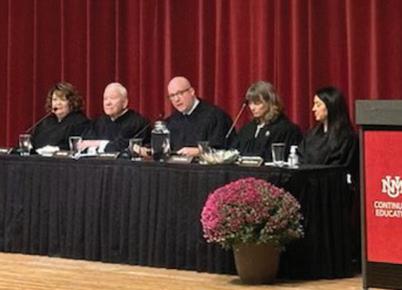
New Mexico Supreme Court Chief Justice David K. Thomson (center) making remarks to New Mexico’s newest attorneys at the Fall 2024 Swearing-In Ceremony, sitting by (from left to right) Justice Julie J. Vargas, Senior Justice Michael E. Vigil, Justice C. Shannon Bacon and Justice Briana H. Zamora.
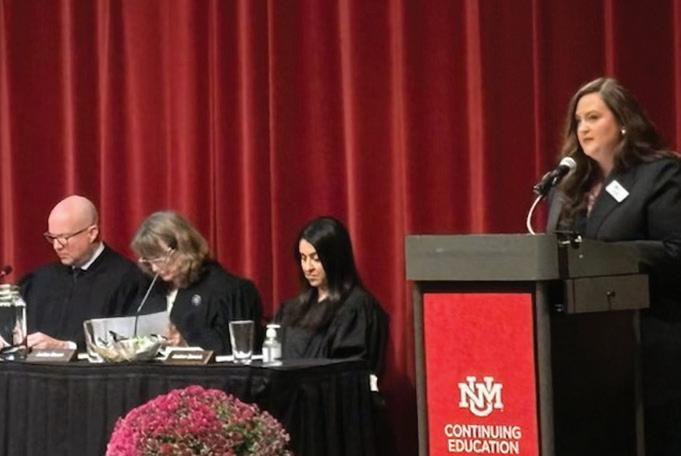
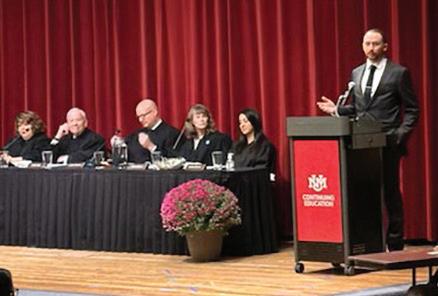
State Bar of New Mexico Young Lawyers Division Chair Randy Taylor giving a speech to New Mexico’s newest attorneys as they enter the legal community in pursuit of justice for New Mexicans.
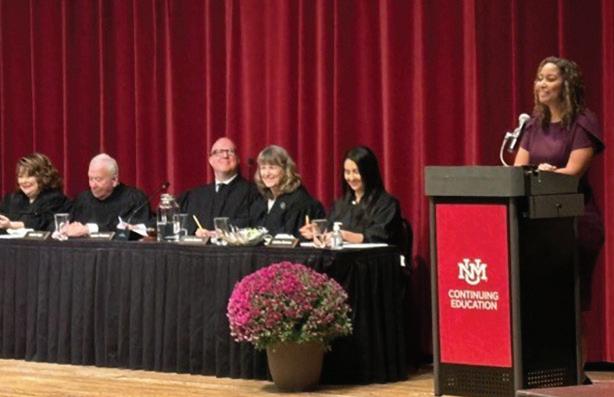
Torri Jacobus, Esq., Director of Statewide Equity, Inclusion, and Justice with the Administrative Office of the Courts, making remarks to new attorneys as they are sworn into the State Bar of New Mexico.
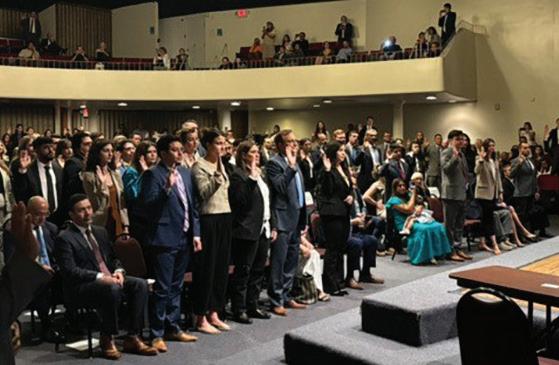
The New Mexico legal community’s newest legal professionals take the oath as they begin their careers as attorneys and carve their paths within the legal field.
13 2024 Cannabis Law Institute
4.0 G, 1.0 EP, 1.0 EIJ
In-Person or Webinar
Center for Legal Education of NMSBF www.sbnm.org
14 2024 Probate Law Institute
6.0 G, 1.0 EP
Webinar
Center for Legal Education of NMSBF www.sbnm.org
14 Elimination of Bias-Combating Age Bias in the Legal Field 1.0 EIJ
Webinar
Center for Legal Education of NMSBF www.sbnm.org
15 Prove It or Lose It: Evidence and Jury Instructions
6.5 G
Web Cast (Live Credits) New Mexico Trial Lawyers Association & Foundation www.nmtla.org
15 Real Property Institute
3.0 G, 1.0 EP
In-Person or Webinar
Center for Legal Education of NMSBF www.sbnm.org
5 The Andrea Taylor Sentencing Advocacy Workshop 2024 18.0 G Live Program Administrative Office of the U.S. Courts www.uscourts.gov
6 2024 Guardian ad Litem Training
5.7 G, 1.2 EIJ
In-Person or Webinar
Center for Legal Education of NMSBF www.sbnm.org
19 The Latest AI in the Legal Profession
1.0 EP
Web Cast (Live Credits) Third Judicial District Court thirddistrict.nmcourts.gov
19 2024 Business Law Institute
5.0 G, 1.0 EP
In-Person or Webinar
Center for Legal Education of NMSBF www.sbnm.org
19 Practical Lessons in Diversity, Equity & Inclusion in Law Practice 1.0 EIJ
Teleseminar
Center for Legal Education of NMSBF www.sbnm.org
20 newTLA Lunch’n Learn Series: Secrecy v. Transparency in Discovery 1.5 G
Live Program New Mexico Trial Lawyers Association & Foundation www.nmtla.org
20 2024 Alternative Dispute Resolution Institute
2.5 G, 1.5 EP, 1.0 EIJ
Webinar
Center for Legal Education of NMSBF www.sbnm.org
7 Navigating Cybersecurity Regulations in a Digital World
2.0 G, 1.0 EP, 1.0 EIJ
Webinar
Center for Legal Education of NMSBF www.sbnm.org
11 State Bonding Overview and Considerations for Drafting Bond Related Legislation
1.0 G
Web Cast (Live Credits)
New Mexico Legislative Council Service www.nmlegis.gov
20 Killers of the Flower Moon: The Osage Murders and How Attorneys Can Combat Bias
1.0 EIJ
Webinar
Center for Legal Education of NMSBF www.sbnm.org
20 Ethics and Changing Law Firm Affiliation
1.0 EP
Teleseminar
Center for Legal Education of NMSBF www.sbnm.org
21 2024 Immigration Law Institute 3.0 G
In-Person or Webinar
Center for Legal Education of NMSBF www.sbnm.org
22 Making Victim’s Rights Meaningful: Advocating for Victims in the Criminal Courts
1.5 G, 0.5 EP
In-Person or Webcast
DWI Resource Center/Victims Rights Project www.victimsrightsnm.org
11 2024 New Mexico Tax Law Symposium
5.2 G, 1.0 EP, 1.0 EIJ
In-Person or Webinar
Center for Legal Education of NMSBF www.sbnm.org
13 End-of-Year Ethics and Equity in Justice
2.0 EP, 1.0 EIJ Live Program
New Mexico Trial Lawyers Association & Foundation www.nmtla.org
Listings in the Bar Bulletin Legal Education Calendar are derived from course provider submissions and from New Mexico Minimum Continuing Legal Education. All MCLE approved continuing legal education courses can be listed free of charge. Send submissions to notices@sbnm.org. Include course title, credits, location/ course type, course provider and registration instructions. For a full list of MCLE-approved courses, visit https://www.sbnm.org/Search-For-Courses.
The Supreme Court of New Mexico Announces 2024
http://www.nmcompcomm.us/
The Supreme Court has approved a number of changes to the rules, forms, and uniform jury instructions (UJIs) for the 2024 rulemaking cycle under Rule 23-106.1 NMRA. What follows is a summary of those changes approved by the Court on November 1, 2024. The summary also includes out-of-cycle amendments approved by the Court on November 1, 2024. Unless otherwise noted below and in the history note at the end of each approved rule, form, or UJI, amendments will take effect on December 31, 2024. The full text of the amendments in markup format and the related orders are available on the Court’s website by visiting https://supremecourt.nmcourts.gov/2024-approvedamendments-to-rules-and-forms/. Approved rule amendments will also appear on NMOneSource.com by their effective date.
Attorney Withdrawal Before Certiorari – Amended Rule 12-302 NMRA
The Supreme Court approved the Appellate Rules Committee’s recommendation to amend Rule 12-302 NMRA and its associated committee commentary to clarify the withdrawal process for appellate counsel appointed by the Court of Appeals in appeals involving abuse or neglect, termination of parental rights, or custody hearings.
Permanency Review Hearings – Amended Rules 10-345 and 10-346 NMRA
On recommendation of the Children’s Court Rules Committee, the Supreme Court approved amendments to Rule 10-346 NMRA requiring the Children, Youth and Families Department to submit a court report five (5) days before a judicial review hearing in child welfare cases. The changes are intended to reflect and implement practices in numerous jurisdictions and mirror the court report requirement for permanency review hearings. The Court also approved technical changes to Rule 10-345 NMRA.
Child’s First Appearance on a Delinquency Petition – Amended Form 10-711 NMRA
The Supreme Court approved the Committee’s recommended amendments to Form 10-711 NMRA. The approved amendments eliminate references to an arraignment, replace language describing procedure in delinquency cases, and clarify the explanation of rights section and ensure that the section is consistent with Rule 10-224 NMRA. The approved amendments also require the child’s attorney to certify that the attorney explained the possible penalties for the alleged offenses to the child.
Political Activity and Elections – Amended Rule 21-401 NMRA
On recommendation of the Code of Judicial Conduct Committee, the Court approved amending Rule 21-401 NMRA to correct a typographical error in the title of the rule.
Lawyer Succession Rule – Amended Rule 16-119 NMRA
The Supreme Court approved the Code of Professional Conduct Committee’s recommended amendments to Rule 16-119 NMRA that exempt justices, judges, and court hearing officers from the succession plan requirement for judicial duties and that clarify that the succession plan requirement otherwise applies to every lawyer with an active license to practice law in New Mexico. The Court also approved the Committee’s proposed amendments to Rule 16-119 and its associated committee commentary that accommodate governmental departments and agencies and clarify the required contents of a succession plan, the potential role of a non-lawyer designee in implementing a succession plan, and how confidentiality requirements apply to assisting lawyers.
http://www.nmcompcomm.us/
Providing Financial Assistance to Clients –Amended Rule 16-108 NMRA
The Supreme Court approved the Committee’s recommendation to amend Rule 16-108 NMRA and its associated committee commentary to allow lawyers to provide indigent clients that they are representing pro bono with modest humanitarian aid under limited circumstances. These amendments are intended to be consistent with the American Bar Association Model Rules of Professional Conduct
Kinship Guardianship Forms – New Form 4A-503.1 NMRA; Amended Forms 4A-501, 4A-502, 4A-503, 4A-504, 4A-505, 4A-506, 4A-507, 4A-508, 4A-509, 4A-510, 4A-511, 4A-512, 4A-513, 4A-514, 4A-515, and 4A-516 NMRA
On recommendation of the Domestic Relations Rules Committee, the Supreme Court approved amendments to the kinship guardianship forms that are intended to comport with recent updates to the Kinship Guardianship Act, NMSA 1978, §§ 40-10B-1 to -15 (2001, as amended through 2023), and the enactment of the Indian Family Protection Act, NMSA 1978, §§ 32A-28-1 to -42 (2022, as amended through 2023). The Court also approved the recommended amendments that ensure a second parent is identified and notified from the inception of a kinship guardianship case.
Parentage Forms – New Forms 4A-404 and 4A-405 NMRA; Amended Form 4A-401 NMRA; Withdrawn Form 4A-403 NMRA
The Supreme Court approved the Committee’s recommendation to adopt new Forms 4A-404 and 4A-405 NMRA, amend Form 4A401 NMRA, and withdraw Form 4A-403 NMRA to streamline the filing of pleadings and orders in parentage cases. The new forms and amendments also clarify procedures for child support and reflect statutory changes to child support.
Forms 4A-310 and 4A-311 NMRA
The Supreme Court approved the Committee’s recommendation to amend Forms 4A-310 and 4A-311 NMRA to update the website address that a petitioner must use to verify the respondent’s active duty military status for purposes of requesting a default judgment and to correct a typographical error.
Three-Day Service and Legal Holidays – Amended Rules 1-006, 2-104, 3-104, 5-104, 6-104, 7-104, 8-104, 10-107, and 12-308 NMRA
On recommendation of the Rules of Civil Procedure for State Courts Committee, the Rules of Criminal Procedure for State Courts Committee, and the Children’s Court Rules Committee, the Supreme Court approved amending Rules 1-006, 2-104, 3-104, 5-104, 6-104, 7-104, 8-104, and 10-107 NMRA to eliminate the additional three-day mailing period when service is made by electronic transmission. The Court also approved identical amendments to Rule 12-308 NMRA. Finally, the Court approved amendments to update the list of legal holidays observed by the judiciary.
Mediation – Amended Rule 2-805 NMRA
The Supreme Court approved the Rules of Civil Procedure for State Courts Committee’s recommendation to amend Rule 2-805 NMRA to eliminate the requirement that mediators be approved by the local presiding judge.
The Supreme Court approved the Committee’s recommended amendments to Form 4-930 NMRA that require a petitioner to provide additional contact information for the relevant parties in a petition for appointment of a treatment guardian for an adult. The Court also approved technical amendments to the form.
Garnishment – Amended Rules 1-065.1, 1-065.2, 2-801, 2-802, 3-801, and 3-802 NMRA; Amended Forms 4-803, 4-805, 4-805A, 4-806, 4-807, 4-808, 4-808A, 4-809, 4-810, and 4-812 NMRA
On recommendation of the Committee, the Court approved the amendment of various civil rules and forms to incorporate recent statutory changes related to garnishment and execution. The Court also approved recommended amendments that clarify when an application for writ of garnishment or execution is considered timely.
http://www.nmcompcomm.us/
Rules of Criminal Procedure for State Courts Committee
Incorporation of Plea Deadlines and Settlement Conferences – Amended Rules 5-304, 6-302, and 7-302 NMRA
The Supreme Court approved the Rules of Criminal Procedure for State Courts Committee’s recommended amendments to Rules 5-304, 6-302, and 7-302 NMRA that impose deadlines for the submission of plea agreements that would eliminate the need for a trial at the district, magistrate, and metropolitan courts. These amendments are intended to conform with the deadlines as set forth in Supreme Court Order Nos. 22-8500-018 and 23-8500-012. The Court also permanently approved the 2022 provisional amendments to Rule 5-304 that allow judicial involvement in plea discussions at the district courts to streamline the processing of criminal cases.
Filing of Criminal Complaint Upon Arrest – Amended Rules 5-210, 6-201, 7-201, and 8-201 NMRA
The Supreme Court approved the Committee’s proposed amendments to Rules 5-210, 6-201, 7-201, and 8-201 NMRA and their associated committee commentary that require a copy of a criminal complaint be given to a defendant and the local detention center at the time of custody and that the original complaint be filed with the court within seventy-two (72) hours if a defendant is not in custody.
Consolidated Cases – New Rules 5-305, 6-307, 7-307, and 8-307 NMRA
In Torres v. Santistevan, 2023-NMSC-021, ¶ 17, 536 P.3d 465, the Court requested that the Committee define the effect of consolidation within the rules of criminal procedure. The Court has approved the Committee’s recommendation to adopt new rules that govern the consolidation of criminal cases, including the effect of consolidation.
Plea Deadlines, Suppression Hearings, and Extensions for Trial – Amended Rules 5-212, 5-601, 6-304, 6-506, 7-304, and 7-506 NMRA
In conjunction with the amendments regarding plea deadlines, the Supreme Court approved the Committee’s recommended amendments to Rules 6-506 and 7-506 NMRA that clarify that the time for commencement of trial may be extended on withdrawal of a plea by a defendant or on rejection of a plea by the court. The Court also approved the Committee’s proposed amendments to the committee commentary of Rules 5-212, 5-601, 6-304, and 7-304 NMRA that encourage courts to resolve substantive motions at least five (5) days prior to trial.
State Bar of New Mexico
Carry-Over Limit for Self-Study MCLEs – Amended Rule 18-201 NMRA
On recommendation of the State Bar of New Mexico, the Supreme Court approved amendments to Rule 18-201 NMRA that remove the carry-over limit for self-study Minimum Continuing Legal Education (MCLE) credit hours. These amendments are intended to implement Supreme Court Order No. S-1-AO-2023-00024 and ensure consistency with the 2023 amendments to Rule 18-204 NMRA.
Rule Set 15 Citations – Amended Rules 24-102, 24-102.2, and 24-110 NMRA
The Supreme Court approved the State Bar of New Mexico’s recommendation to amend Rules 24-102, 24-102.2, and 24-110 NMRA to update references to rules contained in Rule Set 15 – Rules Governing Admission to the Bar following comprehensive amendments to that rule set in 2023.
Supreme Court
Homeowner Assistance Fund – Amended Form 4-227 NMRA; Withdrawn Forms 4-228, 4-229, and 4-230 NMRA
The Supreme Court approved the amendment of Form 4-227 NMRA and the withdrawal of Forms 4-228, 4-229, and 4-230 NMRA due to the expiration of funds under the Homeowner Assistance Fund allocated by the United States Department of Treasury.
Proposed Public Censures – New Rules 17-317 and 27-404 NMRA; Amended Rules 17-211, 17-316, 27-301, and 27-401 NMRA
The Supreme Court approved the adoption of new Rules 17-317 and 27-404 NMRA and the amendment of Rules 17-211, 17-316, 27-301, and 27-401 NMRA, which require the Disciplinary Board and Judicial Standards Commission to submit proposed public censures to the Court when public censure is a recommended form of discipline for judges and attorneys, in accordance with Supreme Court Order No. S-1-AO-2023-00025.
http://www.nmcompcomm.us/
Supplemental Briefs and Authorities – Amended Rule 12-318 NMRA
The Supreme Court approved amendments to Rule 12-318 NMRA that require counsel to file and serve a notice of supplemental authority in accordance with Rule 12-307 NMRA. The Court also approved minor, technical amendments throughout the rule.
Typos and Technical Changes – Amended Rules 2-101, 3-101, 5-101, 6-101, 7-101, 8-101, 12-405, and 24-101.1 NMRA; Amended Form 4A-515 NMRA; Amended UJIs 14-631, 14-1630 NMRA
The Supreme Court approved amending a form and various rules and UJIs to correct typographical errors and make minor, technical changes.
Requests for Oral Argument – Amended Rule 12-319 NMRA
On its own motion, the Supreme Court has amended Rule 12-319 NMRA to clarify and streamline the process for requesting oral argument in the appellate courts. Parties may now request oral argument on the cover page or first page of the opening brief.
Human Rights Act Intentional Discrimination – Amended UJI 13-2307C NMRA
The Supreme Court approved the UJI-Civil Committee’s recommendation to amend UJI 13-2307C NMRA and its associated committee commentary to clarify the standard of discriminatory intent required to prove a violation of the Human Rights Act (HRA), NMSA 1978, §§ 28-1-1 to -14 (1969, as amended through 2024). The approved amendments also provide updated use notes and reflect recent case law as well as legislative changes to the HRA.
Firearm Enhancement – Amended UJIs 14-6013 and 14-6014 NMRA
On recommendation of the UJI-Criminal Committee, the Supreme Court approved amendments to UJIs 14-6013 and 14-6014 NMRA that implement recent changes to the firearm enhancement statute, NMSA 1978, Section 31-18-16 (2022), and the repeal of NMSA 1978, Section 31-18-16.1 (1993, repealed 2003).
THE RULE AMENDMENTS SUMMARIZED ABOVE CAN BE VIEWED IN THEIR ENTIRETY AT THE NEW MEXICO SUPREME COURT WEBSITE
https://supremecourt.nmcourts.gov/2024-approved-amendments-to-rules-and-forms/
From the New Mexico Supreme Court
From the New Mexico Supreme Court
Opinion Number: 2024-NMSC-017
No: S-1-SC-37948 (filed June 10, 2024)
SOCORRO ELECTRIC COOPERATIVE, INC., Appellant, v.
NEW MEXICO PUBLIC REGULATION COMMISSION, Appellee, and
NEW MEXICO INSTITUTE OF MINING AND TECHNOLOGY and CITY OF SOCORRO, Interveners.
In the Matter of the Filing of Advice Notice No. 69 by Socorro Electric Cooperative, Inc.
NMPRC Case No. 18-00383-UT
APPEAL FROM THE NEW MEXICO PUBLIC REGULATION COMMISSION
Wiggins, Williams & Wiggins, PC
Lorna M. Wiggins
Patricia Green Williams Albuquerque, NM for Appellant
Judith Ellen Amer, Associate General Counsel Santa Fe, NM for Appellee
Rodey, Dickason, Sloan, Akin & Robb, P.A.
Charles K. Purcell
Mark Kidee Adams
Cynthia A. Loehr Albuquerque, NM
for Intervenor New Mexico Institute of Mining and Technology
Stelzner, Winter, Warburton, Flores, Sanchez & Dawes, P.A.
Nann M. Winter
Keith W. Herrmann Albuquerque, NM
for Intervenor City of Socorro
I. INTRODUCTION
{1} The Public Utility Act (PUA) grants the New Mexico Public Regulation Commission (Commission) “general and exclusive power and jurisdiction to regulate and supervise every public utility in respect to its rates.” NMSA 1978, § 62-6-4(A) (2003). The PUA also distinguishes rural electric cooperatives from other public utilities with respect to the setting of rates. NMSA
1978, § 62-3-2(A)(3) (1985). While the PUA generally grants the Commission broad powers to review rates proposed by utilities before those rates take effect, NMSA 1978, § 62-8-7(B) (2011), the PUA provides that rates proposed by a rural electric cooperative “shall become effective as proposed” unless certain conditions are met. Section 62-8-7(H). Specifically, Section 62-8-7(H) provides that, before the Commission can inquire into the reasonableness of a cooperative’s proposed rates, a certain number of cooperative members must file objections to the rates, and the
http://www.nmcompcomm.us/
Commission must find that there is just cause for review.
{2} The Socorro Electric Cooperative, Inc., (SEC) is a public utility and rural electric cooperative organized under the Rural Electric Cooperative Act (RECA), NMSA 1978, §§ 62-15-1 to -37 (1939, as amended through 2021). SEC appeals from an order of the Commission rejecting rates proposed by SEC and directing SEC to adopt rates which the Commission determined to be just and reasonable. Relying on the limited nature of the Commission’s jurisdiction over rural electric cooperatives, SEC argues that the Commission’s order exceeds the agency’s authority. In essence, SEC contends that the Commission had no power to fix different rates for SEC but could only approve or deny the rates as proposed. SEC also asserts that the order is arbitrary and capricious and is not supported by substantial evidence. The Commission responds that it properly exercised its authority to fix just and reasonable rates for SEC and defends its ratemaking decisions. The Commission is supported on appeal by the City of Socorro (the City) and the New Mexico Institute of Mining and Technology (New Mexico Tech), who are both members and ratepayers of SEC. {3} For the reasons discussed herein, we determine that once the Commission’s jurisdiction under Section 62-8-7(H) is invoked, the Commission has plenary authority to resolve the issues identified in the ratemaking proceeding and may determine the just and reasonable rates to be charged by a cooperative in accordance with Section 62-8-7(C) and (D). We also conclude that the Commission’s denial of SEC’s proposed rates and other ratemaking decisions are within the scope of the Commission’s authority under Section 62-8-7(H), are reasonable, and are supported by substantial evidence. We therefore affirm the Commission’s final order. NMSA 1978, § 62-11-5 (1982).
II. BACKGROUND
{4} In December 2018, SEC filed an Advice Notice informing the Commission that it was proposing to increase rates by approximately $1.25 million or 5.06% from its 2017 test year. See P.N.M. Gas Servs. v. N.M. Pub. Util. Comm’n (PNM Gas), 2000NMSC-012, ¶ 6, 129 N.M. 1, 1 P.3d 383 (explaining the test-year method). SEC also proposed to reallocate revenue collections among its customer classes because a Cost of Service Study procured by SEC had revealed significant subsidization of its residential, lighting, and irrigation classes. SEC similarly proposed to redesign several of its rates, including adding a $5.00 per month “Minimum Use Charge” applicable to its low-usage customer accounts.
{5} Several SEC members filed protests with the Commission objecting to the proposal’s failure to demonstrate that the rate increase was “fair, just and reasonable.” The Commission later found that a sufficient number of SEC’s members had filed valid and timely protests and that the protests constituted just cause for the Commission to review the proposed rates. The Commission notified SEC that it would hold an evidentiary hearing on several issues broadly related to the reasonableness of the rates and appointed a Hearing Examiner to oversee the proceedings.
{6} During the months leading up to the hearing, the Hearing Examiner ordered SEC to provide more information about the method that SEC had relied upon to calculate its proposed revenue requirement. The Hearing Examiner explained that rural electric cooperatives commonly use a debt service coverage ratio to determine their revenue needs. Debt service coverage ratios measure a cooperative’s ability to pay long-term debt. In response to the Hearing Examiner’s order, SEC indicated that it had not used a debt service coverage ratio to calculate its revenue requirement, but instead had used a cashmargins methodology. SEC’s proposed revenue requirement therefore was set as “a function of the margins and cash necessary to meet the financial objectives set by the Board of Trustees.”
{7} The Hearing Examiner also presided over an evidentiary hearing on SEC’s proposed rates. Among other exhibits and testimony, SEC submitted the testimony of its CEO, Joseph Herrera. Although Herrera cited various declining market factors as supporting the proposed rates, he admitted that SEC did not need increased revenue to maintain its financial integrity or its ability to continue serving customers. Instead, Herrera stated, consistent with SEC filings, that the proposed rates were designed to provide margins that achieved the SEC Board of Trustees’ financial objectives, which he identified as growing SEC’s equity, maintaining SEC’s cash reserves, maintaining adequate debt service coverage ratios, and providing sufficient revenue to fund the retirement of member patronage credits of approximately $688,000 per year. See NMSA 1978, § 62-15-20 (1939) (addressing patronage refunds to members of rural electric cooperatives).
{8} The City, New Mexico Tech, and a residential customer who had intervened in the proceedings submitted opposing testimony and evidence. For example, New Mexico Tech’s expert witness opined that the Commission should deny SEC’s proposed revenue increase because SEC was “generating adequate reserves to meet its obligations” with a “debt coverage ratio within an acceptable range.” The City also
submitted documentary evidence showing that SEC’s sales had remained relatively constant and that SEC’s gross revenues had increased since 2013.
{9} The Hearing Examiner later issued a Recommended Decision advising the Commission to deny SEC’s proposed increased rates. The Hearing Examiner suggested that the Commission reject SEC’s cash-margins method of calculating its revenue requirement, explaining that she was “unaware of any [Commission] docketed rural electric cooperative rate case in which a cooperative or the Commission has calculated the revenue requirement based on the cash margins required to meet a cooperative board’s goals.” The Hearing Examiner instead noted that the Commission had consistently used a debt service coverage ratio to determine a rural electric cooperative’s revenue needs. After considering the characteristics of SEC and the evidence available in the record, the Hearing Examiner concluded that the “Operating Times Interest Earned Ratio” (OTIER) provided an effective debt service coverage ratio method for evaluating SEC’s need for a revenue increase.
{10} As explained by the Hearing Examiner, a cooperative’s OTIER is calculated by comparing the cooperative’s “net operating margins” (defined as the excess of revenue from electricity sales over operating expenses) to the cooperative’s interest expense on long-term debt. A cooperative’s OTIER thus measures “how many times a cooperative earns its interest expense. An OTIER of 1.0 essentially means that a cooperative is earning just enough to pay its interest.” SEC had supplied evidence that in 2017 its OTIER was 1.21 and that in 2018 its OTIER was 1.37. SEC’s 2017 OTIER of 1.21 thus meant that “it had about 20% on top of the minimum available to pay interest expense.” The Hearing Examiner also noted that the Rural Utilities Service, a division of the United States Department of Agriculture and SEC’s primary lender, requires SEC to maintain a minimum OTIER of 1.10. 7
C.F.R. § 1710.114(b)(1) (2023). Based on data provided by Commission Staff, the Hearing Examiner stated that three other New Mexico rural electric cooperatives comparable to SEC had OTIERs between 1.32 and 1.46. New Mexico Tech’s expert further confirmed that a maximum target OTIER for rural electric cooperatives is in the range of 1.3 to 1.5. The Hearing Examiner thus concluded that SEC’s 2018 OTIER of 1.37 fell within an “acceptable range.”
{11} SEC’s proposed revenue increase would raise its OTIER to 1.84. The Hearing Examiner found that SEC had not proved the need to raise its OTIER to this proposed ratio, specifically noting that
http://www.nmcompcomm.us/
Herrera had admitted that SEC’s financial integrity and ability to serve customers would not be compromised if it did not receive the rate increase. The Hearing Examiner also explained that the financial data in SEC’s 2017 and 2018 annual reports confirmed that “it is unnecessary to authorize SEC a higher OTIER.” For example, the Hearing Examiner found that in 2017, SEC was able to retire $423,406 in patronage credits and add $3,850,194 in net value of its plant. From 2017 to 2018, SEC’s patronage capital balance increased to over $1.4 million, its OTIER increased by 13.2%, and its operating margin increased by 21.9% to $569,256. As explained by the Hearing Examiner, SEC’s “operating margin is effectively its profit.”
{12} The Hearing Examiner concluded that it was “crystal clear” that SEC sought increased revenues to advance the Board of Trustees’ objectives of increasing equity, growing cash margins, and seeking earlier retirement of patronage credits. The Hearing Examiner noted that, throughout the proceeding, “SEC seem[ed] to believe that it is entitled to its proposed revenue increase because its Board is entitled to advance or achieve its goals.” The Hearing Examiner suggested, however, that “[w]hether a rural electric cooperative’s proposed rates are just and reasonable is not determined by whether the rates allow the Board to advance or achieve its goals.”
The Hearing Examiner instead emphasized, “‘[U]nder the PUA, a rate is just and reasonable when it balances’” the interests of the “cooperative management—the Board and the General Manager—and the members/ratepayers” (quoting Att’y Gen. v. N.M. Pub. Regul. Comm’n, 2011-NMSC034, ¶ 13, 150 N.M. 174, 258 P.3d 453 (citation omitted)). The Hearing Examiner stated, “[d]enial of a revenue increase will require SEC’s Board to juggle its goals,” but concluded that SEC’s current rates would allow “SEC to earn margins that the Board can use toward meeting its goals.”
{13} Although the Hearing Examiner recommended denying the proposed increased rates, she agreed that it was appropriate to reallocate revenue collections due to significant subsidization among SEC’s customer classes. However, the Hearing Examiner disagreed with SEC’s proposed reallocation, noting specifically that this Court has discouraged using cost of service as a sole criterion in designing rates. The Hearing Examiner instead explained that a “guiding principle” was to move each customer class to full cost of service contribution “in a gradual manner that avoids rate shock.”
{14} For example, a Cost of Service Study procured by SEC showed that revenues allocated to the Residential class would have to increase by 29.10%, revenues allocated
to the Lighting class would have to increase by 21.28%, and revenues allocated to the Irrigation class would have to increase by 89.87% for each of these classes to contribute to its full cost of service. SEC had proposed less significant increases of 6.66% for the Residential class, 10.26% for the Irrigation class, and 9.08% for the Lighting class. The Hearing Examiner recommended only slight increases of 2% for the Residential class and 3% for the Irrigation class, explaining that the Commission had received “persuasive public policy reasons for not further reducing the alleged subsidy” to the Residential class and that this reallocation would gradually lead to each class contributing fully to its cost of service. The Hearing Examiner recommended that revenues allocated to the Lighting class “remain unchanged” because she found the Cost of Service Study “overstated” the subsidy to this class. {15} Similarly, the Cost of Service Study showed that revenues allocated to the Large Commercial class would have to decrease by 17.38% and revenues allocated to the Load Management class would have to decrease by 16.00% to reflect those classes’ full cost of service. Although the Cost of Service Study recommended commensurate decreases for these classes, SEC had proposed increases of 2.66% for the Large Commercial class and 3.35% for the Load Management class. The Hearing Examiner rejected both the Study’s and SEC’s proposed reallocations, concluding that “[a] just and reasonable outcome is to allocate an approximate 1.73%, or $20,000, base revenue decrease to the Load Management Service Class, and an approximate 1.9%, or $181,674, base revenue decrease to the Large Commercial Service Class.”
The Hearing Examiner also recommended that the Commission make several adjustments to SEC’s proposed rate design, including rejecting the proposed $5.00 per month “Minimum Use Charge” for SEC’s Residential, Energy Thermal Storage, and Small Commercial classes because “it would be punitive to low-use customers and result in rate shock.”
{16} The Commission later rejected SEC’s exceptions and fully adopted the Hearing Examiner’s Recommended Decision in a final order. SEC filed a timely notice of appeal. NMSA 1978, § 62-11-1 (1993); Rule 12-601 NMRA.
III. STANDARD OF REVIEW
{17} As the party appealing the Commission’s final order, SEC bears the burden to show that the order is unreasonable or unlawful. NMSA 1978, § 62-11-4 (1965). We will annul and vacate the order if it is arbitrary or capricious, unsupported by substantial evidence, outside of the scope of the Commission’s authority, or otherwise contrary to law. Albuquerque
Bernalillo Cnty. Water Util. Auth. v. N.M. Pub. Regul. Comm’n (ABCWUA), 2010NMSC-013, ¶ 17, 148 N.M. 21, 229 P.3d 494.
{18} When reviewing orders from the Commission, we keep in mind that “Commission decisions requiring expertise in highly technical areas, such as utility rate determinations, are accorded considerable deference.” El Vadito de los Cerrillos Water Ass’n v. N.M. Pub. Serv. Comm’n, 1993-NMSC-041, ¶ 11, 115 N.M. 784, 858 P.2d 1263. We accord less deference “when reviewing determinations outside the realm of the Commission’s expertise.”
Id. “Because statutory construction itself is not a matter within the purview of the Commission’s expertise, we afford little, if any, deference to the Commission on this matter.” N.M. Indus. Energy Consumers v. N.M. Pub. Regul. Comm’n (NMIEC), 2007-NMSC-053, ¶ 19, 142 N.M. 533, 169 P.3d 105 (internal quotation marks and citation omitted). However, we “will confer a heightened degree of deference to legal questions that implicate special agency expertise or the determination of fundamental policies within the scope of the agency’s statutory function.” Morningstar Water Users Ass’n v. N.M. Pub. Util. Comm’n, 1995-NMSC-062, ¶ 11, 120 N.M. 579, 904 P.2d 28 (internal quotation marks and citation omitted).
{19} SEC primarily asserts that the Commission exceeded the scope of its jurisdiction and authority. “The Commission is an administrative body created by statute and obtains authority and jurisdiction expressly or by necessary implication from the statute creating it.” El Vadito, 1993-NMSC-041, ¶ 12. The extent of the Commission’s jurisdiction and authority are questions of law which we review de novo. See NMIEC, 2007-NMSC-053, ¶ 19. We accord little deference to the Commission’s interpretation of its own jurisdiction. Doña Ana Mut. Domestic Water Consumers Ass’n v. N.M. Pub. Regul. Comm’n, 2006-NMSC-032, ¶ 7, 140 N.M. 6, 139 P.3d 166.
{20} SEC also argues that the Commission’s decision is not supported by substantial evidence. A decision is supported by substantial evidence if a review of the whole record reveals credible evidence “that is sufficient for a reasonable mind to accept as adequate to support the conclusion reached by the agency.” NMIEC, 2007-NMSC-053, ¶ 24 (internal quotation marks and citation omitted). We view the record in the light most favorable to the Commission’s decision, PNM Gas, 2000NMSC-012, ¶ 4, and we will not substitute our judgment for that of the Commission if the decision is supported by substantial evidence on the record as a whole, Doña Ana, 2006-NMSC-032, ¶ 11.
http://www.nmcompcomm.us/
{21} SEC further contends that the Commission’s decision is arbitrary and capricious. “‘A ruling by an administrative agency is arbitrary and capricious if it is unreasonable or without a rational basis, when viewed in the light of the whole record.’” Pub. Serv. Co. of N.M. v. N.M. Pub. Regul. Comm’n (PNM), 2019-NMSC-012, ¶ 16, 444 P.3d 460 (quoting Rio Grande Chapter of Sierra Club v. N.M. Mining Comm’n, 2003-NMSC-005, ¶ 17, 133 N.M. 97, 61 P.3d 806).
IV. DISCUSSION
A. The Business Judgment Defense Has Been Incorporated in This Court’s Standard of Review {22} SEC primarily challenges the Commission’s final order as unlawful. Specifically, SEC asserts that the order invades the exclusive prerogative of the SEC’s Board of Trustees to set financial objectives for SEC, to choose a method of calculating SEC’s revenue requirement, and to allocate revenues and design rates. In support of this argument, SEC cites the United States Supreme Court’s opinion in Missouri ex rel. Southwestern Bell Telephone Co. v. Public Service Commission of Missouri, 262 U.S. 276 (1923), which indicates that “while the state may regulate with a view to enforcing reasonable rates and charges, it is not the owner of the property of public utility companies, and [it] is not clothed with the general power of management incident to ownership.” Id. at 289.
{23} We assess that SEC is relying on a “business judgment” or invasion of management defense to the Commission’s regulation of its rates. Although we have recognized the applicability of this defense in certain contexts, we have also recognized that, in the century since Southwestern Bell was decided, “[t]he ‘invasion of management’ prohibition . . . has waned.” PNM Elec. Servs. v. N.M. Pub. Util. Comm’n (PNM Electric), 1998NMSC-017, ¶ 21, 125 N.M. 302, 961 P.2d 147. We now understand that regulatory commissions have “substantial latitude in protecting the public” and “that commissions are generally empowered to act in areas seemingly reserved to management prerogative where the regulated action is ‘impressed with the public interest.’” Id. (quoting Pub. Serv. Co. of Okla. v. State ex rel. Corp. Comm’n ex rel. Loving, 1996 OK 43, ¶ 25, 918 P.2d 733). Thus, in PNM Electric, we affirmed a New Mexico Public Utility Commission order rejecting a utility’s application to provide nonutility services to its customers. 1998-NMSC017, ¶¶ 2-9. Although we acknowledged that the Commission’s authority to insert itself into the internal affairs of a utility is limited, id. ¶ 21, we also noted that the Commission had found that the nonutility services could have affected the utility’s
ability to provide its public services at fair, just, and reasonable rates. Id. ¶¶ 7, 17-18. We therefore concluded that the Commission did not exceed its authority by rejecting the utility’s application and instead suggesting that the utility could provide the nonutility services through “unregulated corporate subsidiaries.” Id. ¶¶ 18, 24.
{24} According to PNM Electric, when reviewing an order from the Commission, we do not separately consider whether the Commission invaded the business judgment or prerogative of a utility’s management. Id. ¶ 22 Rather, the invasion of management defense has been incorporated into our standard of review, which provides that the Commission may not exceed its constitutional or statutory mandate, act arbitrarily or capriciously, or make a decision which is unsupported by substantial evidence. Id. (citing Mountain States Tel. & Tel. Co. v. Wyoming Pub. Serv. Comm’n, 745 P.2d 563, 568-70 (Wyo. 1987)). This is because the PUA only regulates activities that the Legislature has deemed to be of public concern, and thus activities that are not “‘impressed with the public interest’” will fall outside the scope of the Commission’s authority under the PUA. PNM Electric, 1998-NMSC-017, ¶¶ 21-22.
{25} For example, we have held that the Commission’s jurisdiction does not extend to private contract or tort actions involving a utility. Sw. Pub. Serv. Co. v. Artesia Alfalfa Growers’ Ass’n, 1960-NMSC-052, ¶¶ 18-23, 67 N.M. 108, 353 P.2d 62; see also Summit Props., Inc. v. Pub. Serv. Co. of N.M., 2005NMCA-090, ¶¶ 9-13, 138 N.M. 208, 118 P.3d 716. Likewise, we have held that the Commission may not place conditions on the provision of nonutility services in a certificate of public convenience and necessity absent findings that those services will affect the public interest. Plains Elec. Generation & Transmission Coop., Inc. v. N.M. Pub. Util. Comm’n, 1998-NMSC-038, ¶¶ 6, 23-26, 126 N.M. 152, 967 P.2d 827. Similarly, we have held that the Commission may not fix a debt ratio for a utility, as debt ratio is “strictly” a decision for the utility’s internal management. State Corp. Comm’n v. Mountain States Tel. & Tel. Co., 1954-NMSC-044, ¶ 54, 58 N.M. 260, 270 P.2d 685. But we have also held that the Commission may impute a capital structure to a utility for the purpose of ratemaking, as this is an important consideration in the setting of just and reasonable rates. Zia Nat. Gas Co v. N.M. Pub. Util. Comm’n, 2000-NMSC-011, ¶¶ 6-10, 128 N.M. 728, 998 P.2d 564; see also Mountain States, 1954-NMSC-044, ¶ 54 (“Debt ratio is strictly a matter for management, but its evalu[a]tion in fixing rates is an item for serious consideration by the rate-making
body.”). The Commission may not regulate private or internal matters of a utility because these matters fall outside the scope of the Commission’s authority under the PUA. See PNM Electric, 1998-NMSC-017, ¶ 22. But the Commission’s regulatory authority does not necessarily end where a utility’s business judgment begins. {26} PNM Electric guides our disposition of SEC’s arguments in this appeal. The Legislature has expressly recognized that the Commission may regulate a rural electric cooperative’s rates and that the regulation of these rates is a matter of public concern. Section 62-8-7(H); see also Section 62-3-2(A) (extending coverage of the PUA to rural electric cooperatives because it is essential to the “public health, safety and welfare” of the state). Thus, the rates at issue were “impressed with public interest” so as to fall within the scope of the Commission’s regulatory authority. PNM Electric , 1998-NMSC-017, ¶ 21. Therefore, consistent with PNM Electric, we do not consider whether the Commission invaded SEC’s business judgment. Instead, we view the relevant questions as being whether the Commission’s order is within the scope of the Commission’s authority, whether the order is arbitrary and capricious, and whether the order is supported by substantial evidence. Id. ¶ 22. We resolve these questions in the remainder of this opinion.
B. The Legislature Authorized the Commission to Set Just and Reasonable Rates for Rural Electric Cooperatives
{27} As explained in the preceding section, we view SEC’s assertion that the Commission invaded its internal management prerogative as a challenge to the scope of the Commission’s authority under the PUA. SEC essentially contends that the Commission has no power to modify a rural electric cooperative’s proposed rates but that the Commission is limited to either approving or denying the rates as proposed. Thus, in disposing of this argument, we consider whether the Commission exceeded its authority when it rejected SEC’s proposed rates and instead ordered SEC to adopt rates that the Commission determined to be just and reasonable. {28} We therefore construe Section 628-7(H) to ascertain the scope of the Commission’s authority over a rural electric cooperative once the agency’s ratemaking jurisdiction has been invoked. “When construing statutes, our guiding principle is to determine and give effect to legislative intent.” NMIEC, 2007-NMSC-053, ¶ 20. When ascertaining legislative intent, we first look to the language of the statute and will give words their ordinary meaning unless the Legislature indicates a contrary meaning is intended. ABCWUA, 2010-
http://www.nmcompcomm.us/
NMSC-013, ¶ 52. We interpret statutory language in the context of the statute as a whole and in a way that facilitates the achievement of legislative purpose. Baker v. Hedstrom, 2013-NMSC-043, ¶ 15, 309 P.3d 1047. We also “consider the history and background of the statute” and “closely examine the overall structure of the statute we are interpreting, as well as the particular statute’s function within a comprehensive legislative scheme.” State v. Rivera, 2004-NMSC-001, ¶ 13, 134 N.M. 768, 82 P.3d 939. “Statutory language that is clear and unambiguous must be given effect.” ABCWUA , 2010-NMSC-013, ¶ 52 (internal quotation marks and citation omitted). However, “where statutory language is doubtful, ambiguous, or an adherence to the literal use of the words would lead to injustice, absurdity or contradiction, we construe a statute according to its obvious spirit or reason.” Grisham v. Reeb, 2021-NMSC-006, ¶ 12, 480 P.3d 852 (internal quotation marks and citation omitted).
{29} As previously noted, the PUA generally grants the Commission plenary authority to regulate public utility rates. Section 62-6-4(A); see also City of Albuquerque v. N.M. Pub. Serv. Comm’n, 1993NMSC-021, ¶ 25, 115 N.M. 521, 854 P.2d 348 (“Our holding that the Commission retains plenary authority over ratemaking recognizes that ratemaking is a matter of statewide rather than local concern.”); City of Albuquerque v. N.M. Pub. Regul. Comm’n, 2003-NMSC-028, ¶ 8, 134 N.M. 472, 79 P.3d 297 (“[R]atemaking is a matter of statewide rather than local concern and the [Commission] retains plenary authority over ratemaking.” (internal quotation marks and citation omitted)). However, the PUA limits the Commission’s jurisdiction over a rural electric cooperative by placing conditions that must be satisfied before the Commission may regulate a cooperative’s rates. Section 62-8-7(H) provides, in part, that rates proposed by a rural electric cooperative “shall become effective as proposed by the rural electric cooperative . . . without a hearing, except as provided in this subsection.” The statute further provides:
Upon the filing with the commission of a protest setting forth grounds for review of the proposed rates signed by the lesser of one percent of or twenty-five members of a customer rate class of the rural electric cooperative . . . and if the commission determines that there is just cause for reviewing the proposed rates on one or more of the grounds of the protest, the commission shall suspend the rates and conduct a hearing concerning the
reasonableness of any proposed rates filed by a rural electric cooperative or a foreign distribution cooperative pursuant to Subsections C and D of this section.
. . . The hearing and review shall be limited to the issues set forth in the protest and for which the commission may find just cause for the review, which issues shall be contained in the notice of hearing.
Section 62-8-7(H). Thus, the Commission’s review of a rural electric cooperative’s rates is conditioned on the filing of a sufficient number of member protests and a finding of just cause for review. Id. Once those conditions are satisfied, the Commission must conduct a hearing on the reasonableness of the proposed rates pursuant to Section 62-8-7(C) and (D), and the hearing is limited to the issues raised in the protests for which the Commission finds just cause for review. Id.
{30} Section 62-8-7(C) and (D) are the general subsections of the PUA that grant the Commission authority to review and decide the reasonableness of any public utility’s change in rates. As relevant to our analysis, Section 62-8-7(D) provides that, if the Commission finds a rate proposed by a utility “to be unjust, unreasonable or in any way in violation of law,” then the Commission shall determine the just and reasonable rates to be charged or applied by the utility for the service in question and shall fix the rates by order to be served upon the utility[,] or the commission by its order shall direct the utility to file new rates . . . determined by the commission in its order to be just and reasonable.
{31} By the plain language of Section 62-8-7(D) and (H), once the Commission’s jurisdiction is invoked, the Commission has authority and mandate to determine whether a cooperative’s proposed rates are just and reasonable. If the Commission finds those rates are unreasonable, then the Commission may fix just and reasonable rates for that cooperative. The statutory language does not suggest that the Commission’s authority in a Section 62-8-7(H) proceeding is limited to approving or rejecting the rates as proposed by a cooperative.
{32} SEC emphasizes the language in Section 62-8-7(H), which states that the Commission is required to “conduct a hearing concerning the reasonableness of any proposed rates filed by a rural electric cooperative.” SEC reasons that this language expresses an intent to limit the Commission’s review only to determining the reasonableness of the rates as proposed.
However, we note that the language in Section 62-8-7(H) regarding the Commission conducting a hearing on the reasonableness of a rural electric cooperative’s proposed rates is similar to language in Section 62-8-7(C) regarding the Commission’s review of the reasonableness of rates proposed by any public utility. Compare Section 62-8-7(H) (“[T]he commission shall . . . conduct a hearing concerning the reasonableness of any proposed rates filed by a rural electric cooperative . . . pursuant to Subsections C and D of this section.”), with Section 62-8-7(C) (“[T]he commission may, upon complaint or upon its own initiative, except as otherwise provided by law, upon reasonable notice, enter upon a hearing concerning the reasonableness of the proposed rates.”). In view of this similarity and Section 62-8-7(H)’s express incorporation of Section 62-8-7(C) and (D), we do not read Section 62-8-7(H) as expressing a legislative intent to limit the Commission’s authority to fix a just and reasonable rate for a cooperative.
{33} SEC nevertheless argues that the differing treatment of rural electric cooperatives under the PUA reveals a legislative intent to limit the Commission’s ratemaking powers. Unlike investor-owned utilities, the board of trustees of a rural electric cooperative is elected by the cooperative members, and thus the members have some amount of control over the decisions of the cooperative. See § 62-15-9(A) (providing that a rural electric cooperative will be managed by a board of trustees elected by the members of the cooperative). Section 62-3-2(A)(3) thus recognizes that “rural electric cooperatives are substantially different from investor-owned utilities, particularly relative to setting rates,” and that “the costs to rural electric cooperatives and the public at large in complete government regulation of their rates is greatly disproportionate to the need and benefits of complete rate regulation and interferes with the setting of fair, just and reasonable rates to all utilities.”
{34} While we acknowledge the differing treatment of cooperatives under the PUA, we conclude that the Legislature has expressed an intent to distinguish rural electric cooperatives from investorowned utilities only with respect to the procedures involved in the setting of rates.
See Tri-State Generation & Transmission Ass’n, Inc. v. N.M. Pub Regul. Comm’n, 2015-NMSC-013, ¶¶ 14-18, 347 P.3d 274 (explaining that the PUA distinguishes between cooperatives and investor-owned public utilities with respect to invocation of the Commission’s jurisdiction). The Legislature has not distinguished between rural electric cooperatives and other public utilities with respect to the substance or nature of the Commission’s
http://www.nmcompcomm.us/
ratemaking powers. See id. ¶ 9 (concluding in a similar context that the Commission has plenary authority to set a generation and transmission cooperative’s rates under Section 62-6-4(D) once the Commission’s jurisdiction is invoked).
{35} Section 62-3-2(A)(3) states that the Legislature’s purpose in extending coverage of the PUA to rural electric cooperatives is, in part, “to provide procedures for setting rates of rural electric cooperatives different from and more limited than those for setting rates of investor-owned utilities.” (Emphasis added.) Further, the Legislature has stated that its purpose in regulating rural electric cooperatives is, in part, “to establish a system which will more adequately provide for the development and extension of reasonable and proper utility services at fair, just and reasonable rates.” Section 62-3-2(A)(4). This language is similar to the Legislature’s statement of purpose for regulating other public utilities. See, e.g., NMSA 1978, § 62-3-1(B) (2008) (“It is the declared policy of the state that the public interest, the interest of consumers and the interest of investors require the regulation and supervision of public utilities to the end that reasonable and proper services shall be available at fair, just and reasonable rates.”). Because the Legislature has identified a similar purpose for regulating both the rates of rural electric cooperatives and other public utilities, we conclude the Legislature has not expressed an intent to limit the Commission’s powers to fix a just and reasonable rate in a Section 62-8-7(H) ratemaking proceeding.
{36} The legislative history of Section 62-8-7(H) confirms that the Legislature intended to distinguish between rural electric cooperatives and other Commission-regulated utilities only with respect to the procedures relating to the Commission’s review of rates. It otherwise intended to treat rural electric cooperatives and public utilities equally with respect to the Commission’s power to determine the just and reasonable rates to be charged by a utility. Originally, the PUA did not regulate rural electric cooperatives. See Morningstar, 1995-NMSC-062, ¶¶ 34-38 (discussing the history of regulating rural electric cooperatives under the PUA). Consequently, SEC was unable to invoke the Commission’s regulatory powers when it sought to prevent another utility from extending service into SEC’s service area. Socorro Elec. Coop. v. Pub. Serv. Co., 1959-NMSC-105, ¶¶ 1-2, 22, 66 N.M. 343, 348 P.2d 88, superseded by statute as stated in Edington v. N.M. Pub. Serv. Comm’n, 1964-NMSC-248, ¶ 6, 74 N.M. 647, 397 P.2d 300 (citing 1961 PUA enactments “deleting the exclusion of rural electric cooperatives”).
{37} In 1961, shortly after our opinion in Socorro Electric, the Legislature amended the PUA to include rural electric cooperatives as public utilities covered under the act. N.M. Laws 1961, ch. 89, § 2(F) (1); Morningstar, 1995-NMSC-062, ¶ 36. However, the Legislature only granted the Commission jurisdiction to regulate a rural electric cooperative’s rates in territories where there was an overlapping certificate of public convenience and necessity granted to another utility “for the same class of service.” N.M. Laws 1961, ch. 89, § 5. Rural electric cooperatives also were not required to service the public. Morningstar, 1995-NMSC-062, ¶ 36.
{38} In Community Public Service Co. v. N.M. Public Service Commission, 1966NMSC-053, ¶ 9, 76 N.M. 314, 414 P.2d 675, we held that the distinctions between rural electric cooperatives and other utilities under the 1961 version of the PUA violated equal protection. Unlike rural electric cooperatives, other regulated utilities had to serve the public, and their rates and services were fully regulated by the Commission; thus, these other utilities were placed at a decided disadvantage to rural electric cooperatives. Id. We could perceive no “rational basis for permitting an electric cooperative . . . entire freedom from control of its rates,” while the other utilities were “required to charge for such service only such rates as the Commission approves.” Id. ¶ 11.
{39} The year after our opinion in Community Public, “the legislature went back to the drawing board” and redrafted the RECA to provide that, in the event of a conflict between the RECA and the PUA, the PUA would control. Morningstar , 1995-NMSC-062, ¶ 37. The Legislature similarly explained that its intent in extending coverage of the PUA to rural electric cooperatives was to make cooperatives “subject to all the burdens and entitled to all the benefits which apply to public utilities generally.” N.M. Laws 1967, ch. 96, § 9(A)(3). In 1985, the Legislature further amended the PUA to state that there was a rational basis supporting the adoption of different procedures for setting rural electric cooperative rates and limited the Commission’s power to review the reasonableness of the rates on the filing of sufficient protests and a finding of just cause for review. N.M. Laws 1985, ch. 176, § 1(A)(3), § 2(F). We ascertain that, in making these amendments to the PUA and the RECA, the Legislature sought to rectify the constitutional infirmity identified in Community Public by distinguishing between rural electric cooperatives and other utilities only with respect to the procedures for setting rates. {40} SEC additionally argues that the RECA, which grants broad powers to a
cooperative’s board of trustees to govern the cooperative’s affairs, supports a legislative intent to limit the Commission’s ratemaking powers over a cooperative. See § 62-15-9(G) (“The board of trustees may exercise all of the powers of a cooperative except such as are conferred upon the members by the [RECA] or its articles of incorporation or bylaws.”). Contrary to SEC’s arguments, we conclude that the general powers granted to a cooperative’s board of trustees under the RECA do not constrain the Commission’s authority under Section 62-8-7(H) to fix a just and reasonable rate. The PUA expressly provides, “Nothing contained in any other act governing the creation and operation of rural electric cooperatives which are public utilities, including [the RECA] shall be construed to conflict with any duty to which such a utility may be subject . . . under the [PUA], as now or hereafter amended.” Section 62-3-2(C). The RECA has nearly identical language. Section 6215-32 (“Nothing contained in the [RECA] shall be construed, however, to conflict with any duty to which a cooperative is subject . . . under [the PUA].”). Thus, even if the RECA reveals an intent to limit the Commission’s ratemaking powers, the relevant standards of the PUA will control.
See Elec. Serv. in San Miguel Cnty. v. Pub. Serv. Comm’n of N.M., 1985-NMSC-038, ¶ 7, 102 N.M. 529, 697 P.2d 948 (“In the event of any conflict between the [PUA] and the [RECA], both Acts provide that the PUA will control.”).
{41} For those reasons, we hold the Commission retains plenary authority to resolve the issues identified in a Section 62-8-7(H) proceeding and may fix just and reasonable rates for a rural electric cooperative or order the cooperative to propose new rates that the Commission has determined to be just and reasonable. Section 62-8-7(D), (H). As SEC does not otherwise contend that the Commission’s jurisdiction was improperly invoked under Section 62-8-7(H), we further conclude that the Commission did not exceed its statutory authority by rejecting the rates proposed by SEC and by ordering SEC to adopt rates that the Commission determined to be just and reasonable. We turn next to SEC’s specific challenges to the Commission’s ratemaking decisions.
C. The Commission’s Decision to Reject SEC’s Proposed Revenue Requirement Is Lawful, Reasonable, and Supported by Substantial Evidence
{42} We next consider whether the Commission’s decision to reject SEC’s proposed revenue requirement is unlawful, arbitrary and capricious, or unsupported by substantial evidence.
http://www.nmcompcomm.us/
1. The Commission lawfully rejected SEC’s proposed revenue increase {43} SEC challenges as unlawful the Commission’s decision to deny its proposed revenue requirement, arguing that the Commission attempted to set financial objectives for SEC by denying a revenue increase. As we have stated herein, we reaffirm that the Commission has limited authority to regulate the internal affairs of a cooperative, PNM Electric , 1998NMSC-017, ¶¶ 21-22, but we also hold that the Commission may determine the just and reasonable rates to be charged by a cooperative in accordance with Section 62-8-7(C), (D), and (H). See also NMSA 1978, § 62-8-1 (1941) (“Every rate made, demanded or received by any public utility shall be just and reasonable.”). On review, we conclude that the Commission did not set financial objectives for SEC by rejecting SEC’s proposed revenue requirement. Rather, the Commission denied SEC’s proposed rates because it determined that the rates were not just and reasonable and that SEC had not shown a need for increased revenue.
{44} The just and reasonable standard of the PUA requires rates to be “neither unreasonably high so as to unjustly burden ratepayers with excessive rates nor unreasonably low so as to constitute a taking of property without just compensation or a violation of due process by preventing the utility from earning a reasonable rate of return on its investment.” PNM Gas, 2000-NMSC-012, ¶ 8. We have explained that, to set a just and reasonable rate, the Commission must balance “the public interest, the interests of consumers, and the interests of investors in public utility companies.” N.M. Att’y Gen. v. N.M. Pub. Regul. Comm’n, 2013-NMSC-042, ¶ 20, 309 P.3d 89. In the context of a rural electric cooperative, the interests to be balanced are those of the public, the cooperative’s members or customers, and its board of trustees. Cf. § 62-3-2(A)(3) (“[R] ural electric cooperatives are nonprofit membership corporations whose members have direct control over the cooperative’s rates through an elected board of trustees. Generally, consumers of the cooperative’s power are members.”).
{45} We conclude that the Commission’s decision to deny SEC’s proposed revenue requirement is consistent with the Commission’s duty to set just and reasonable rates. Essentially, the Commission determined that SEC was not entitled to a revenue increase that would attain all SEC’s financial objectives because those objectives were outweighed by the interests of the public and of SEC’s members and customers. SEC has not shown that this decision resulted in rates that exceed the “‘zone of reasonableness’ in which rates
November 13, 2024

Center for Legal Education courses pre-approved to meet new MCLE Requirements:
• Newly required Equity in Justice Credit: All attorneys must complete 1.0 Equity in Justice (EIJ) credit in each compliance year. Annual compliance now includes 2.0 EP credits, 1.0 EIJ credit and 9.0 General credits. For more details, read Rule 18201(D) and (E) NMRA . Note: In accordance with the Rule, excess EIJ credits “can be converted to be used toward the substantive (general) requirement.”
• Cap on Self-Study Credits Lifted: Now all 12 required MCLE credits may be Self-Study, Virtual or InPerson credits. There is no longer a 4.0-credit cap on Self-Study courses; however, only pre-approved Self-Study courses are allowed. For more details, read Rule 18-204(C) NMRA
Equity in Justice Courses
Save with the Annual Pass
More November/December Programs
The Center for Legal Education is a nonprofit New Mexico accredited CLE course provider dedicated to providing high-quality, affordable educational programs to the legal community. The Center offers a full range of educational services. For more information, contact us or visit us online.

NOVEMBER 14
Elimination of Bias–Combating Age Bias in the Legal Field
1.0 EIJ
11 a.m.–Noon Webinar
NOVEMBER 19
Practical Lessons in Diversity, Equity & Inclusion in Law Practice
1.0 EIJ
11 a.m.–Noon Teleseminar
NOVEMBER 20
Killers of the Flower Moon: The Osage Murders and How Attorneys Can Combat Bias
1.0 EIJ
11 a.m.–Noon Webinar
DECEMBER 10
Discovering Implicit Biases in Jury Selection
1.0 EIJ
11 a.m.–Noon Webinar
DECEMBER 17
Learn Mindfulness to Curtail Implicit Bias and Make Ethical Decisions
1.0 EIJ
11 a.m.–Noon Webinar
DECEMBER 19
Killers of the Flower Moon: The Osage Murders and How Attorneys can Combat Bias
1.0 EIJ
11 a.m.–Noon Webinar
DECEMBER 20
Elimination of Bias–Combating Age Bias in the Legal Field
1.0 EIJ
11 a.m.–Noon Webinar
DECEMBER 20
Thurgood Marshall’s Coming!
2.8 EIJ
1–4 p.m. Webinar
DECEMBER 31
Why Women Attorneys Get Paid Less: What's Gender Bias Got to Do With it
1.0 EIJ
11 a.m.–Noon Webinar
Any Center for Legal Education programs designated as EIJ credit are pre-approved to meet the new Equity in Justice Credit requirement found in Rule 18-201(D) and (E) NMRA. In accordance with the Rule, excess EIJ credits “can be converted to be used toward the substantive (general) requirement."
November 13:
2024 Cannabis Law Institute
4.0 G, 1.0 EP, 1.0 EIJ
November 20:
2024 Alternative Dispute Resolution Institute
2.5 G, 1.5 EP, 1.0 EIJ
December 6:
2024 Family Guardian Ad Litem Training
5.7 G, 1.2 EIJ
December 7: Navigating Cybersecurity Regulations in a Digital World
2.0 G, 1.0 EP, 1.0 EIJ
December 11: 2024 New Mexico Tax Law Symposium
5.2 G, 1.0 EP, 1.0 EIJ
December 12: National Negotiation Programs featuring Marty Latz
2.0 EP, 2.0 EIJ
December 17: The CLE Performer – Stuart Teicher
2.0 G, 3.0 EP, 1.0 EIJ Save almost 18% over regular prices!


Credits must be redeemed by: Dec. 31, 2024 Contact us for more info: cleonline@sbnm.org
Redeemable on Center for Legal
NOVEMBER 14
2024 Probate Law Institute
6.0 G, 1.0 EP
8:30 a.m.–5 p.m. Webinar
NOVEMBER 14
Joint Ventures in Real Estate, Part 1
1.0 G
11 a.m.–Noon Teleseminar
NOVEMBER 15
Joint Ventures in Real Estate, Part 2
1.0 G
11 a.m.–Noon Teleseminar
NOVEMBER 15
Virtual Magic: Making Great Legal Presentations Online
1.0 G
11 a.m.–Noon Webinar
NOVEMBER 15
2024 Real Property Institute
3.0 G, 1.0 EP
9 a.m.–2:15 p.m. In-Person & Webinar
NOVEMBER 19
2024 Business Law Institute
5.0 G, 1.0 EP
8:45 a.m.–4:45 p.m. In-Person & Webinar
NOVEMBER 19
Learning Litigation Skills From “Where the Crawdads Sing”
2.0 G
11 a.m.–1 p.m. Webinar
NOVEMBER 20
2024 Alternative Dispute Resolution Institute
2.5 G, 1.5 EP, 1.0 EIJ 9 a.m.–3:15 p.m. Webinar
NOVEMBER 20
Ethics and Changing Law Firm Affiliation
1.0 EP
11 a.m.–Noon Teleseminar
NOVEMBER 21
Baskets and Escrow in Business Transactions
1.0 G
11 a.m.–Noon Teleseminar
NOVEMBER 21
2024 Immigration Law Institute 3.0 G
1–4:30 p.m.
In-Person & Webinar
NOVEMBER 22
Employment Law Torts
1.0 G
11 a.m.–Noon Teleseminar
NOVEMBER 26
Ethics in Negotiations – Boasts, Shading, and Impropriety
1.0 EP
11 a.m.–Noon Teleseminar
NOVEMBER 27
Ethical Issues When You Have a Dishonest Client
1.0 EP
11 a.m.–Noon Teleseminar
DECEMBER 3
That's a Wrap: A Review of Emerging Ethics Issues in 2024
1.0 EP
11 a.m.–Noon Webinar
DECEMBER 3
Hot Tips and Hot Water: Best Practices to Help Reduce Professional Liability Risks
1.0 EP
1–2 p.m. Webinar
DECEMBER 3
Trust and Estate Planning for Pets
1.0 G
11 a.m.–Noon Teleseminar
DECEMBER 4
Drafting Client Engagement Letters in Trust and Estate Planning
1.0 G
11 a.m.–Noon Teleseminar
DECEMBER 6
Buying, Selling and Exchanging Partnership and LLC Interests
1.0 G
11 a.m.–Noon Teleseminar
DECEMBER 6
2024 Family Guardian ad Litem Training
5.7 G, 1.2 EIJ
8:30 a.m.–5 p.m. In Person & Webinar
DECEMBER 7
Navigating Cybersecurity Regulations in a Digital World
2.0 G, 1.0 EP, 1.0 EIJ 9 a.m.–2:15 p.m. Webinar
DECEMBER 10
Ethics of Beginning and Ending Client Relationships
1.0 EP
11 a.m.–Noon Teleseminar
DECEMBER 10
Ethical Issues Relating to Smartphone Use
1.0 EP
1–2 p.m. Webinar
Continued on next page...
DECEMBER 11
Living in a Cloud-based WorldThe Next Generation of Digital Evidence
1.0 G
11 a.m.–Noon Webinar
DECEMBER 11
Ethics, Juror Misconduct, and Jury Tampering: The Murdaugh Motion For New Trial
2.0 EP
1–3 p.m. Webinar
DECEMBER 11
Selection and Preparation of Expert Witnesses in Litigation
1.0 G
11 a.m.–Noon Teleseminar
DECEMBER 11
2024 New Mexico Tax Law Symposium
5.2 G, 1.0 EP, 1.0 EIJ
8 a.m.–4:55 p.m. In Person & Webinar
DECEMBER 12
Negotiation Ethics: Winning Without Selling Your Soul featuring Marty Latz
2.0 EP
10 a.m.–Noon Webinar
DECEMBER 12
Practical Ways to Fight Gender Bias and Sexism in Negotiations featuring Marty Latz
2.0 EIJ
1–3 p.m. Webinar

DECEMBER 12
Piercing the Entity Veil: Individual Liability for Business Acts
1.0 G
11 a.m.–Noon Teleseminar
DECEMBER 12
How to Overcome Substance Use Disorder and Avoid Legal Ethics Issues Using Mindfulness as Part of Your Toolkit
1.0 EP 11 a.m.–Noon Webinar
DECEMBER 12
Make Your Witness a Star!
2.0 G 1–3:15 p.m. Webinar
New courses will be added frequently! Our On-Demand/Self-Study
The Cap on Self-Study Credits is Lifted: Now all 12 required MCLE credits may be Self-Study, Virtual or In-Person credits. There is no longer a 4.0-credit cap on Self-Study courses; however, only pre-approved SelfStudy courses are allowed. For more details, read Rule 18-204(C) NMRA.
For Center for Legal Education pre-approved Self-Study courses, visit our On-Demand/Self-Study library at: cle.sbnm.org/courses/8102
REGISTER EARLY! Advance registration is recommended. Online registration closes one day ahead of each program. CLE Cancellations & Refunds: We understand that plans change. If you find you can no longer attend a program, please contact the Center for Legal Education. We are happy to assist you by transferring your registration to a future CLE event or providing a refund. MCLE Credit Information: The NM State Bar Foundation’s Center for Legal Education is an accredited CLE course provider. Note: Programs subject to change without notice.
are neither ratepayer extortion nor utility confiscation.” PNM, 2019-NMSC-012, ¶ 10 (citation omitted). SEC also has not shown that its financial objectives constituted actual or necessary expenses prudently incurred for the benefit of ratepayers, such that the Commission would have been required to include the objectives in SEC’s rates. See PNM Gas, 2000-NMSC-012, ¶ 68 (explaining that the Commission “has an obligation to allow a utility expenses that are necessary in providing utility service, that benefit ratepayers, and that are prudently incurred” (internal quotation marks and citation omitted)); Section 62-15-20 (providing that member patronage credits are to be paid from revenues “in excess of the amount thereof necessary” to defray expenses and meet other obligations of the cooperative). The Commission also did not direct SEC to condition support for any one of its financial objectives on a revenue increase or prioritize its financial objectives in any particular way. Rather, the Commission limited itself to issues relating to the setting of rates and did not address matters not “impressed with public interest.” PNM Electric, 1998-NMSC017, ¶ 21 (internal quotation marks and citation omitted). We therefore defer to the Commission’s discretion and expertise in concluding that increased revenues would not benefit SEC’s members or ratepayers.
See PNM Gas, 2000-NMSC-012, ¶ 9 (noting that, in meeting its obligation to ensure that every rate is just and reasonable, “‘the Commission is vested with considerable discretion’” (brackets and citation omitted)).
2. The Commission did not act arbitrarily or capriciously or without substantial evidence in denying the revenue increase {46} SEC also argues that the Commission’s rejection of its proposed revenue requirement is arbitrary and capricious. SEC contends that the Commission acted unreasonably in relying on OTIER as a method to calculate SEC’s revenue requirement. SEC asserts that the Commission instead should have used the cash-margins method relied on by its Board of Trustees. {47} However, we have recognized that “[t]he Commission is not bound to the use of any single formula or combination of formulae in determining rates. . . . It is the result reached, not the method employed, which is controlling.” PNM, 2019-NMSC-012, ¶ 10 (brackets, internal quotation marks, and citation omitted). The Commission has broad discretion and authority in setting rates, and this “discretion extends to determining the appropriate method for establishing just and reasonable rates.” N.M. Att’y Gen., 2013NMSC-042, ¶ 33. The Commission was not required to rely on the cash-margins
method advocated by SEC. {48} We also recognize that “the Commission is not free to disregard its own rules and prior ratemaking decisions or to change its position without good cause and prior notice to the affected parties.” PNM, 2019-NMSC-012, ¶ 11 (internal quotation marks and citation omitted). Traditionally, in setting the rates of an investor-owned utility, the Commission has used a rate of return methodology, in which the utility’s revenue requirement is calculated by considering the anticipated costs of operation, a rate base which reflects the current value of the utility’s property and investments, and a reasonable rate of return on the utility’s investment. PNM Gas, 2000-NMSC012, ¶ 6; Hobbs Gas Co. v. N.M. Pub. Serv. Comm’n , 1980-NMSC-005, ¶¶ 5-6, 94 N.M. 731, 616 P.2d 1116. However, the Commission has found the rate of return methodology to be a less useful measure of a rural electric cooperative’s revenue needs. Rural electric cooperatives typically have less equity capital than investorowned utilities, which undermines the rate of return method where equity is a primary consideration. The Commission has therefore relied on a debt service coverage ratio to determine whether rural electric cooperatives are in need of a revenue increase. See, e.g., In re Jemez Mountains Elec. Coop.’s Advice Notice No. 61, Case No. 12-00258-UT, Recommended Decision, 13-15, 26-29 (N.M. Pub. Regul. Comm’n May 20, 2013) (discussing Commission decisions approving revenue requirements from rural electric cooperatives using a debt service coverage approach and recommending approval of a stipulated revenue requirement relying on a debt service coverage approach). In the most recent ratemaking proceeding involving a rural electric cooperative, the Commission relied on the OTIER debt service coverage ratio. In re Filing of Proposed New Rates by Kit Carson Elec. Coop., Inc., Case No. 1500375-UT, Recommended Decision, 75-79 (N.M. Pub. Regul. Comm’n Oct. 31, 2016). {49} In the current proceedings on appeal, SEC received notice that the Commission had previously relied on a debt service coverage ratio to determine the revenue requirement for a rural electric cooperative. The Commission also explained why OTIER was an appropriate measure of SEC’s revenue requirement considering the specific characteristics of SEC and the available evidence in the record. We also emphasize the Commission did not rely solely on OTIER to decide that SEC had not shown the need for a revenue increase because SEC’s CEO admitted that SEC would be financially stable and able to continue serving customers even without the proposed revenue increase, and SEC’s financial information and expert testi-
http://www.nmcompcomm.us/
mony confirmed the factual basis for this admission. The Commission’s consistent application of an OTIER methodology supported by the Commission’s review of financial data to determine SEC’s revenue needs is neither arbitrary nor capricious.
{50} The Commission’s conclusions about SEC’s need for the revenue increase are further supported by exhibits and expert testimony in the record as we have more fully summarized herein by factual background. We conclude that the Commission’s decision to deny SEC’s proposed revenue increase is supported by substantial evidence.
D. The Commission’s Revenue Reallocation and Rate Design Decisions Are Lawful, Reasonable, and Supported by Substantial Evidence
{51} We next consider whether the Commission’s rejection of SEC’s proposed allocation of revenue collections among its customer classes and SEC’s proposed rate design was unlawful, arbitrary and capricious, or unsupported by substantial evidence.
1. The Commission’s reallocation and design decisions are lawful {52} Similar to SEC’s other arguments, SEC suggests that the Commission’s order to reallocate revenues and redesign SEC’s rates is unlawful because the Commission had no power to direct SEC to adopt a different allocation or design but was limited to approving or denying the allocation and design as proposed. However, revenue allocation and rate design are public matters, § 62-3-2(A)(4) (“[T]he rural electric cooperative which is a public utility is subject to reasonable burdens and entitled to reasonable benefits which apply to public utilities generally, to insure . . . reasonable and proper utility services at fair, just and reasonable rates.”), that clearly fall within the issues identified in the Commission’s notice of hearing. Having concluded the Commission had authority to set just and reasonable rates for SEC pursuant to Section 62-8-7(D) and (H), we also conclude the Commission’s reallocation and rate design decisions are therefore lawful.
2. The Commission’s reallocation and design decisions are not arbitrary and capricious and are supported by substantial evidence
{53} SEC has not shown the Commission’s decisions on revenue reallocation and rate design are arbitrary or capricious. For example, SEC asserts that the Commission acted unreasonably when it departed from the allocations recommended by the Cost of Service Study procured by SEC and the allocations proposed by SEC. However, we have specifically “discouraged the use of cost of service as a sole criterion in designing rates.” PNM Gas, 2000-NMSC-012, ¶
100 (citing Mountain States Tel. & Tel. Co. v. N.M. State Corp. Comm’n, 1977-NMSC032, ¶¶ 73-74, 90 N.M. 325, 563 P.2d 588). Moreover, the Commission has not been “required to rely on any one rate-design method.” N.M. Att’y Gen. v. N.M. State Corp. Comm’n, 1996-NMSC-002, ¶ 33, 121 N.M. 156, 909 P.2d 716. Rather, this Court has “acknowledge[d] that the Commission has considerable discretion in the area of rate design,” PNM Gas, 2000-NMSC-012, ¶ 99, and may consider principles such as unity or full cost of service contribution, continuity, stability, and gradualism in avoidance of rate shock. Id. ¶ 102; Mountain States, 1977-NMSC-032, ¶ 73.
{54} Although the Hearing Examiner based her recommendations on the figures and analysis in the Cost of Service Study procured by SEC, the Hearing Examiner recommended that the Commission depart from the proposed allocations. For example, the Hearing Examiner recommended SEC adopt rate increases for the Residential and Irrigation classes that were less significant than the increases proposed by SEC, that SEC not change rates for the Lighting class, and that SEC implement slight decreases in rates for the Load Management and Large Commercial classes. The Hearing Examiner explained that these adjustments were made to support a more gradual movement towards each class contributing to its full cost of service. The Hearing Examiner’s reasoning and recommendations are consistent with the rate design principles used by the Commission and accepted by this Court.
PNM Gas, 2000-NMSC-012, ¶ 102. SEC has not shown that the Hearing Examiner’s application of these principles to its rates is arbitrary or capricious.
{55} SEC also argues that the Commission’s reallocation and design decisions are not based on substantial evidence. But SEC does not attack the Commission’s findings in this regard with particularity. See Rule 12-318(A)(4) NMRA (“A contention that a . . . finding of fact is not supported by substantial evidence shall be deemed waived unless the argument identifies with particularity the fact or facts that are
not supported by substantial evidence.”). Instead, SEC focuses on repeating the evidence supporting its proposed rates. However, “the issue on appeal is not whether there was sufficient evidence to support a contrary result but, rather, whether the evidence supports the findings made by the [Commission].” ABCWUA, 2010-NMSC-013, ¶ 89.
{56} We conclude that SEC has waived its substantial evidence challenge to the findings supporting the Commission’s reallocation and design decisions. Nevertheless, to the extent that SEC generally attacks the Commission’s reallocation and design decisions, we conclude that the Commission’s order is based on substantial evidence. The reasons cited by the Hearing Examiner for the recommended reallocation of revenues among the customer classes, rate structure redesign, and denial of certain customer and minimum use charges are supported by testimony and exhibits in the record as a whole. We therefore defer to the Commission’s expertise and discretion in reallocating revenues and designing SEC’s rates. See Hobbs, 1980-NMSC-005, ¶ 4. E. SEC’s Remaining Issues Fail to Demonstrate Other Grounds for Vacating the Order
{57} SEC asserts there were several “inconsistenc[ies]” in the Commission’s order that the Commission “refused to clarify.” For example, SEC asserts that the Commission has not clarified whether SEC may split its Small Commercial and Residential customers into two customer classes or whether its Lighting rates “are to remain unchanged from SEC’s proposal or SEC’s existing rates.” The Commission responds that the asserted inconsistencies are clarified on careful reading of the Hearing Examiner’s Recommended Decision and the Commission’s final order.
{58} We agree that the asserted inconsistencies are clarified on careful reading of the Recommended Decision and final order. Irrespective of this dispute, SEC shoulders the burden in this appeal of showing that the order is unlawful or unreasonable because it is arbitrary and capricious, not supported by substantial
http://www.nmcompcomm.us/
evidence, outside of the scope of the Commission’s authority, or otherwise contrary to law. PNM , 2019-NMSC-012, ¶ 12. Because the asserted inconsistencies do not approach this standard, they provide no basis for annulling and vacating the Commission’s order.
{59} Finally, SEC asserts the Commission’s decision is unlawful because the Commission lacked authority to order SEC to initiate the process of offering an economic development rate under NMSA 1978, Section 62-6-26 (2015). SEC similarly challenges as unlawful a part of the Commission’s order that addresses installation of replacement lights for its Lighting class customers. However, SEC did not clearly raise these issues in its Brief in Chief and only passingly mentions these issues in its Reply Brief. “It is well established that we will not address issues raised for the first time in the reply brief.” ABCWUA, 2010-NMSC-013, ¶ 59 (internal quotation marks and citation omitted); see also Rule 12-318(C) (providing that the reply brief “shall reply only to arguments or authorities presented in the answer brief”). Further, we will not review inadequately briefed issues. See Citizens for Fair Rates & the Env’t v. N.M. Pub. Regul. Comm’n, 2022-NMSC-010, ¶¶ 2930, 503 P.3d 1138 (declining to rule on an inadequately briefed issue on appeal from a Commission order). For these reasons, we do not reach these issues.
V. CONCLUSION
{60} We conclude that the Commission properly exercised its authority to resolve the issues identified in this Section 62-87(H) proceeding and to fix just and reasonable rates for SEC. SEC has not shown that the Commission’s order is unlawful or unreasonable. Therefore, we affirm the Commission’s order.
{61} IT IS SO ORDERED.
JULIE J. VARGAS, Justice WE CONCUR:
DAVID K. THOMSON, Chief Justice
MICHAEL E. VIGIL, Justice
C. SHANNON BACON, Justice
BRIANA H. ZAMORA, Justice
From the New Mexico Supreme Court
Opinion Number: 2024-NMSC-018
No: S-1-SC-39544 (filed July 25, 2024)
MAILE SOON, Petitioner-Petitioner, v.
JEANNINE KAMMANN, Respondent-Respondent
ORIGINAL PROCEEDING ON CERTIORARI
Gerard J. Lavelle, District Judge
Atkinson & Kelsey, P.A.
Thomas C. Montoya Albuquerque, NM for Petitioner
VIGIL, Justice.
{1} We are reminded yet again that the touchstone of a custody adjudication in New Mexico is not genetics, gender, or family composition, but the best interest of the child. This case requires us to determine whether a person’s admission to not being a genetic parent of a child is sufficient to rebut a presumption of parentage under the New Mexico Uniform Parentage Act (UPA), NMSA 1978, §§ 40-11A-101 to -903 (2009, as amended through 2021). We conclude that it is not. Instead, we hold that the district court must follow the procedures in the UPA, which establish specific admissibility requirements for the results of genetic testing, including a requirement that the district court consider the best interest of the child before
ACLU of New Mexico Foundation
Maureen A. Sanders
Elinor J. Rushforth Albuquerque, NM for Respondent
ordering such testing.
{2} Subsequent to oral argument in this case, we issued an order that Jeannine Kammann is a legal parent to the twin children born to Kammann’s spouse, Maile Soon, during their marriage. Herein, we explain our reasoning.
I.
{3} Soon and Kammann shared a desire to bring children into their relationship. They first began assisted reproduction treatment prior to marrying, and Soon conceived by an intrauterine insemination procedure1 approximately ten months into the marriage. Kammann fully participated in Soon’s prenatal medical care.
{4} The relationship between the two women faltered, and Soon moved out of their shared home during the pregnancy. She subsequently filed for divorce, but the couple remained married when Soon
http://www.nmcompcomm.us/
gave birth. After the twins were born, Kammann visited the twins in the hospital and again after they went home, conferred about their names, and paid child support to Soon.
{5} The custody battle quickly became contentious, and Soon moved to dismiss Kammann’s parentage claim for lack of standing. Soon did not dispute that Kammann was presumed to be a parent of the twins under Section 40-11A-204(A) of the UPA because the children were born during the marriage. But Soon argued that Kammann nevertheless lacked standing under the UPA because Kammann is not genetically related to the twins and therefore, pursuant to the UPA, the marriage presumption was rebutted.
{6} Kammann argued, in relevant part, that it is undisputed that the twins were born during the marriage and that this fact establishes her standing as a presumed parent under the UPA and case law.
{7} After a hearing and additional briefing, the district court ruled in Soon’s favor. At the hearing, Kammann conceded to not being a genetic or biological parent of the twins. The district court accepted that concession, concluding that Kammann is not the genetic or biological parent of the twins and that the marriage-based presumption of parentage was rebutted.
{8} Kammann appealed to the Court of Appeals. Soon v. Kammann, 2022-NMCA066, 521 P.3d 110. She argued in relevant part that the district court was wrong to conclude on the basis of her statements that she was not genetically related to the twins and regarded her courtroom statements as responses constrained to follow statutory procedure. Id. ¶ 10. The Court of Appeals agreed and reversed the district court’s conclusion that Kammann’s statements rebutted the presumption of marriage. Id. ¶ 23.2
{9} Soon appealed to this Court, and we granted certiorari on all questions presented. We held oral argument and ruled that Kammann is a legal parent of the twins. We explain that ruling next, addressing only the issues relevant to our decision and without passing judgment on any issue we do not discuss.
1 “Intrauterine insemination” is a form of assisted reproduction, Section 40-11A-102(D)(1), that involves “introducing sperm into the female reproductive organs by means other than sexual intercourse.” Theresa Glennon, Choosing One: Resolving the Epidemic of Multiples in Assisted Reproduction, 55 Vill. L. Rev. 147, 154 (2010).
2 The Court of Appeals also held that the district court misconstrued UPA provisions providing that parentage can be established if a person consents to assisted reproduction by a woman in a record signed by both “before the placement of the eggs, sperm or embryos.” Section 40-11A-704(A); see also Soon, 2022-NMCA-066, ¶¶ 25, 30. The district court concluded “that the signed consent must relate to the specific procedure that resulted in pregnancy and the eventual birth of the children.” Id. ¶ 26 (emphasis added).
The Court of Appeals disagreed, holding that the district court must examine whether the “written evidence establishes Kammann’s consent to assisted reproduction.” Id. ¶ 31. Soon questioned this ruling, and we granted certiorari on the question presented. However, because we conclude on other grounds that Kammann is a legal parent to the twins, we do not discuss this issue any further.
II. DISCUSSION
{10} Soon argues that the Court of Appeals incorrectly concluded that the UPA requires genetic testing to overcome the marriage presumption of parentage. Instead, Soon argues, it was sufficient that Kammann testified that she was not the genetic or biological mother of the twins. She also argues that, in any event, Kammann’s argument on this point was not preserved in the district court. As stated herein previously, we disagree with Soon and affirm the Court of Appeals on both issues.
A. Standard of Review
{11} “Statutory interpretation is an issue of law, which we review de novo.” Chatterjee v. King, 2012-NMSC-019, ¶ 11, 280 P.3d 283 (citation omitted). “When reviewing a statute, our courts aim to effectuate the Legislature’s intent in passing the statute.” Id. To discern the intent of the Legislature, we look first to the plain language of the statute. Id. When we examine statutory language, we give the words their ordinary meaning unless we determine that a different meaning was intended by the Legislature. Id. {12} “In addition to looking at the statute’s plain language, we will consider its history and background and how the specific statute fits in the broader statutory scheme.” Id. ¶ 12. “Because we consider statutes in the context of the broader act in which they are situated, we read them in conjunction with statutes addressing the same subject matter, ensuring a harmonious, common-sense reading.” Id.
B. The Issue of Whether the Marital Presumption Was Rebutted Was Preserved
{13} Soon argues that Kammann did not preserve the “argument” in the district court that genetic testing was statutorily required to rebut the marriage presumption. But our rules do not require the preservation of arguments, only issues. See Rule 12-321(A) NMRA (“To preserve an issue for review, it must appear that a ruling or decision by the trial court was fairly invoked.”). The issue of whether the marriage presumption was overcome is central to this case. It was argued in the district court and was, therefore, preserved.
C. Kammann’s Admission Under Oath That She Is Not a Genetic or Biological Mother of the Twins Is Not Sufficient to Rebut Her Presumption of Parentage
{14} Soon does not challenge whether Kammann is the presumed parent of the twins. Indeed, as Soon’s spouse at the time of the birth, Kammann is entitled to the marriage presumption and is therefore a presumed parent of the twins. When a child is born during a marriage, as here, the UPA
provides a “presumption of paternity” of the spouse if “he and the mother of the child are married to each other and the child is born during the marriage.” Section 40-11A204(A)(1), (B). Despite this problematically gendered statutory language, Kammann’s gender is irrelevant and is not disqualifying. For several reasons, we construe these statutes expansively to mean that a presumption of parentage, rather than a presumption of paternity, arises when a child is born during a marriage.
{15} First, the UPA itself invites that interpretation: Section 40-11A-106 states that UPA provisions “relating to determination of paternity apply to determinations of maternity insofar as possible.” Second, this Court has already taken a broad, gender-neutral approach to parentage when construing a related UPA provision. See Chatterjee, 2012NMSC-019, ¶¶ 5, 48 (concluding under a prior version of the UPA that a woman can bring a custody action by relying on a provision providing for a presumption of “paternity” based on holding out a child as the woman’s own). Third, a contrary result would seem to be in tension, at the very least, with Griego v. Oliver, which held that “all rights, protections, and responsibilities that result from the marital relationship shall apply equally to both same-gender and oppositegender married couples.” 2014-NMSC-003, ¶ 69, 316 P.3d 865; see also Debbie L. v. Galadriel R., 2009-NMCA-007, ¶¶ 14-16, 145 N.M. 500, 201 P.3d 169 (underscoring that protecting the child’s welfare and maintaining established bonds with psychological parents are critical conditions in custody determinations). Therefore, we construe Section 40-11A-204(A)(1) and (B) broadly and neutrally with respect to gender.3
{16} We turn to the statutory framework at issue. Under the UPA, the parent-child relationship can be established several different ways. See Section 40-11A-201 (describing the ways a parent-child relationship can be established pursuant to the UPA). One way a parent-child relationship is conclusively established is by an unrebutted presumption of parentage, such as the presumption afforded Kammann because the twins were born during her marriage to Soon. Section 40-11A-201(B)(1) (referencing Section 40-11A-204, which establishes the unrebutted assumption of parentage for a person married to the mother when the child is born). This presumption of parentage can be rebutted only pursuant to the adjudication procedures established in UPA Article 6. Section 40-11A-204(B).
{17} In Article 6, the UPA provides that presumed parentage can be disproved by the results of genetic testing, § 40-11A-631(D),
http://www.nmcompcomm.us/
but “only by admissible results of genetic testing,” § 40-11A-631(A). The UPA explicitly defines the admissibility of genetic testing in this context: genetic testing is not admissible “to adjudicate parentage” unless the genetic testing is performed “(1) with the consent of both the mother and the presumed, acknowledged or adjudicated [parent]; or (2) pursuant to an order of the district court.”
Section 40-11A-621(C).
{18} In this case, there was no mutual consent to genetic testing and no district court order to conduct genetic tests, and neither party offered genetic test results. The presumption of parenthood afforded Kammann under Section 40-11A-204(A)(1) was thus unrebutted. Nevertheless, Soon argues that Kammann’s presumption of parentage was rebutted because Kammann admitted that she is not a genetic or biological parent of the twins. Moreover, given the uncontroverted facts of the twins’ conception, genetic parenthood seems impossible.
{19} As stated, we reject Soon’s argument. Soon has not pointed to anything in the UPA to indicate that the specific admissibility requirements established by the Legislature for genetic testing are optional, and we perceive none. It would controvert the intent of the Legislature to allow the presumption of parentage to be overcome on the basis of an alternative, ad hoc, procedure.
{20} Furthermore, and importantly, although genetic testing can provide a basis to rebut the presumption of parenthood afforded married partners under Section 40-11A-631, the absence of a genetic relationship is not necessarily dispositive. Stated otherwise, the lack of a genetic relationship between the presumed parent and the child or children as an existential matter does not conclusively rebut a presumption of parentage. Instead, the UPA provides that even if the presumed parent is not a genetic parent of the child, the marriage presumption can lead to an adjudication of parenthood. Under the UPA, parentage is viewed through the lens of the best interest of the child, not merely the genetics of the individuals involved in the dispute. Section 40-11A-608(B). We explain.
{21} The Legislature has granted the district court the power to deny a motion for genetic testing. Section 40-11A-608. A motion for genetic testing can be denied if the district court determines that “(1) the conduct of the mother or the presumed or acknowledged [parent] estops that party from denying parentage; and (2) it would be inequitable to disprove the [presumed parent’s] relationship [with] the child.” Section 40-11A-608(A). Moreover, the Legislature has provided that the district court must consider the best interest of the child when
3 We rely in this opinion on several other sections of the UPA that also use gendered language, often with references to “paternity” or fatherhood. These include Sections 40-11A-201(B)(1), 40-11A-608(A)-(B), (E), 40-11A-621(C). As necessary, and without further explanation, we take a gender-neutral approach to these sections as well.
deciding whether to grant or deny a motion for genetic testing. See Section 40-11A608(B) (“In determining whether to deny a motion seeking an order for genetic testing pursuant to this section, the district court shall consider the best interest of the child.” (emphasis added)).
{22} And to analyze whether a request for genetic testing should be denied on the basis of the best interest of the child, the district court must consider a nonexhaustive list of nine factors. Section 40-11A-608(B).⁴ Two among these factors are particularly noteworthy. First, the district court must be mindful of the effects on equities that might arise from results of testing that disrupts the parent-child relationship, or must consider “the chance of other harm to the child” if genetic testing were ordered. Section 40-11A608(B)(9). Second, and importantly, the district court must specifically consider the possible harm to the child if the presumed or acknowledged parenthood is disproved by genetic testing. Section 40-11A-608(B) (6). Thus, the procedure established by the Legislature provides that the best interest of the child determines whether the district court should consider genetic testing when determining parentage.
{23} This is consistent with the overarching policy goals of the UPA to “ensur[e] that a child will be cared for, financially and otherwise, by two parents” and to “address the interest that children have in their own support.” Chatterjee, 2012-NMSC-019, ¶¶ 32-33; see also Julio C. Romero, A GenderNeutral Reading of New Mexico’s Uniform Parentage Act: Protecting New Mexican Families Regardless of Sexuality, 43 N.M. L. Rev. 567, 571 (2013) (“[T]he primary purpose of determining parentage under the UPA is to provide support for the child.”). In furtherance of these goals, our appellate courts interpret the UPA to effectuate a broad definition of “parent” in recognition that family structures have evolved in New Mexico. See Chatterjee, 2012-NMSC-019, ¶ 34 (“The law needs to address traditional expectations in light of current realities to keep up with the changing demographic of American families and to protect the children born into them.”). As in this case, we have found occasion to reject constraints imposed by gender, biology,
4 The nine factors are:
and family structure that might undermine the UPA’s primary purpose of ensuring that children have parents who care for and support them.
{24} In Chatterjee, for example, we concluded that a broad, gender-neutral definition of parentage served the best interest of the child, holding that a woman asserting parentage could rely on a UPA presumption of paternity that was seemingly afforded (on the plain language of the statute) to a man that holds out a child as his own. 2012NMSC-019, ¶¶ 9, 18, 20, 48. We noted that the presumption arose not from biology, but from a person’s conduct, and that a narrow focus on biology can come at the expense of the best interest of the child. Id. ¶¶ 15, 46.
{25} In Mintz v. Zoernig, our Court of Appeals concluded that a sperm donor who assumes a parental role must provide child support, even where there was a preconception agreement that he had no obligation to support the child financially. 2008-NMCA162, ¶ 1, 145 N.M. 362, 198 P.3d 861. Applying the holding out provision under the UPA, the Mintz Court concluded that the agreement made by the father to assume a parental role—which he did—without financial responsibilities was unenforceable because the agreement ran afoul of the strong public policy goal favoring parental support of their children. Id. ¶¶ 3, 10-11, 14-15. {26} The best interest of the child test reverberates throughout New Mexico law relating to children, not merely under the UPA. Indeed, our Legislature consistently emphasizes the importance of the best interest of the child in legal determinations affecting children. See, e.g., NMSA 1978, § 40-4-9(A) (1977) (requiring a district court to “determine [child] custody in accordance with the best interests of the child” if the minor is under the age of 14 and prescribing a multifactor test); NMSA 1978, § 40-12-2 (1987) (stating that “[t]he purpose of the Domestic Relations Mediation Act is to assist the court . . . in determining the best interests of the children involved in domestic relations cases”); NMSA 1978, § 32A-1-3(A) (2009) (stating that the legislative purpose of the Children’s Code is “first to provide for the care, protection and wholesome mental and physical development of children” with the
http://www.nmcompcomm.us/
“child’s health and safety” being “the paramount concern”); NMSA 1978, § 40-10B10(C) (2001) (requiring a guardian ad litem to “report to the court concerning the best interests of the child”); NMSA 1978, § 32A1-4(F) (2023) (defining “court-appointed special advocate[s]” who “assist the court in determining the best interests of the child by investigating the case and submitting a report to the court”).
{27} In this case, like Chatterjee and Mintz, the outcome is driven by the requirement that courts must consider the interests of the child, regardless of the circumstances of conception or familial permutation. Because the UPA and this Court prioritize a child’s interest in being “cared for . . . by two parents” and because of “the interest that children have in their own support,” Chatterjee, 2012-NMSC019, ¶¶ 32-33, we resist rigid constraints of biology, gender, and family structure when analyzing parentage issues. See Vest v. State ex rel. N.M. Hum. Servs. Dep’t, 1993-NMCA144, ¶ 19, 116 N.M. 708, 866 P.2d 1175 (“We are not prepared to assume that the welfare of children is best served by a narrow definition of those whom we permit to continue to manifest their deep concern for a child’s growth and development.” (internal quotation marks and citation omitted)). The district court, by circumventing the procedure established in the UPA with regard to genetic testing, impermissibly failed to consider the best interest of the child.
III. CONCLUSION
{28} For the reasons stated, we hold that Kammann’s marriage presumption of parentage, which is viewed through the lens of the best interest of the child, is unrebutted as established in the UPA. Additionally, no genetic test results were admitted pursuant to the required procedures established in the UPA. Accordingly, Kammann is a parent of the twin children.
{29} IT IS SO ORDERED.
MICHAEL E. VIGIL, Justice WE CONCUR:
DAVID K. THOMSON, Chief Justice C. SHANNON BACON, Justice NANCY J. FRANCHINI, Judge Sitting by designation CINDY. M. MERCER, Judge Sitting by designation
(1) the length of time between the proceeding to adjudicate parentage and the time that the presumed or acknowledged father was placed on notice that he might not be the genetic father;
(2) the length of time during which the presumed or acknowledged father has assumed the role of father of the child;
(3) the facts surrounding the presumed or acknowledged father’s discovery of his possible nonpaternity;
(4) the nature of the relationship between the child and the presumed or acknowledged father;
(5) the age of the child;
(6) the harm that may result to the child if presumed or acknowledged paternity is successfully disproved;
(7) the nature of the relationship between the child and any alleged father;
(8) the extent to which the passage of time reduces the chances of establishing the paternity of another man and a child-support obligation in favor of the child; and
(9) other factors that may affect the equities arising from the disruption of the father-child relationship between the child and the presumed or acknowledged father or the chance of other harm to the child.
Electronic decisions may contain computer-generated errors or other deviations from the official version filed by the Court of Appeals.
Filing Date: 9/25/2024
No. A-1-CA-40529
MARALYN BECK, Plaintiff-Appellee, v. STATE OF NEW MEXICO ex rel. CHILDREN, YOUTH & FAMILIES DEPARTMENT, Defendant-Appellant.
APPEAL FROM THE DISTRICT COURT OF BERNALILLO COUNTY
Victor S. Lopez, District Court Judge
Western Agriculture, Resource and Business Advocates, LLP
A. Blair Dunn
Jared R. Vander Dussen Albuquerque, NM for Appellee
Long, Komer & Associates, P.A.
Nancy R. Long
Jonas M. Nahoum Santa Fe, NM for Appellant
This appeal is brought under the Inspection of Public Records Act (IPRA), NMSA 1978, §§ 14-2-1 through -12 (1947, as amended through 2023). Defendant Children, Youth, and Families Department (CYFD) appeals the district court’s judgment requiring CYFD to make available for inspection in response to Plaintiff Maralyn Beck’s request the names, email addresses, and physical addresses2 of CYFD licensed foster parents. CYFD redacted this personally identifying information from its responses to Plaintiff’s requests for emails, text messages, and meeting notes mentioning Plaintiff by name, and refused to disclose a list of foster parents’ names, email addresses, and physical addresses altogether in its response to Plaintiff’s second request, claiming that the names and other personally-identifying information of foster parents sought by Plaintiff is exempt from disclosure under the catchall, “as otherwise provided by law” exception to IPRA inspection. See § 142-1(L). View full PDF online.
Jane B. Yohalem, Judge I CONCUR:
Jacqueline R. Medina, Judge Shammara H. Henderson, Judge, dissenting.
To read the entire opinion, please visit the following link: https://bit.ly/A-1-CA-40529
This decision of the New Mexico Court of Appeals was not selected for publication in the New Mexico Appellate Reports. Refer to Rule 12-405 NMRA for restrictions on the citation of unpublished decisions. Electronic decisions may contain computer-generated errors or other deviations from the official version filed by the Court of Appeals.
No. A-1-CA-40268
First Alamogordo Bancorp of Nevada, Inc. v. Steven E. William
Introduction of Opinion
In this mortgage foreclosure case, Defendant-Appellant Steven Williams (Appellant) appeals from the district court’s “Order Denying Motion to Set Aside Judgment and Sale” (the Order or Order Denying Rule 1-060(B) Motion). In the “Motion to Set Aside Judgment and Sale” (the Motion or Rule 1-060(B) Motion), filed pursuant to Rule 1-060(B)(1), (3), (4) and (6) NMRA, Appellant sought, inter alia, to set aside the district court’s order granting “Summary Judgment” (the Summary Judgment) in favor of Plaintiff-Appellee First Alamogordo Bancorp of Nevada, Inc., d/b/a First National Bank (Appellee) and the subsequent orders approving the sale of two commercial properties owned by two limited liability companies (the LLCs) of which Appellant was a member. View full PDF online.
Gerald E. Baca, Judge WE CONCUR:
Jacqueline R. Medina, Judge Jane B. Yohalem, Judge
To read the entire opinion, please visit: https://bit.ly/A-1-CA-40268
No. A-1-CA-40964
Nationstar Mortgage, LLC v. Frank Lukasavage
Introduction of Opinion
Appellee Nationstar Mortgage, LLC instituted foreclosure proceedings against Appellants Frank and Sharon Lukasavage, among other named Defendants. The district court entered separate orders granting in rem summary judgment as to Appellants’ interest in the underlying property, and dismissing Appellants’ counterclaims. On appeal, Appellants challenge both orders, claiming the district court erred by (1) violating the rules of judicial conduct; (2) granting summary judgment and failing to consider their counterclaims; (3) denying their motion to strike an affidavit; (4) denying their motion to set aside an order granting discovery sanctions against them; (5) dismissing their amended counterclaims; and (6) acting without jurisdiction to grant in rem summary judgment. Unpersuaded, we affirm.
Jacqueline R. Medina, Judge WE CONCUR:
J. Miles Hanisee, Judge Gerald E. Baca, Judge
To read the entire opinion, please visit: https://bit.ly/A-1-CA-40964
No. A-1-CA-40807
State of New Mexico v. Carl Gage
Introduction of Opinion
Defendant Carl Gage was convicted of sixteen offenses arising from six burglaries and one attempted burglary he committed in Taos, New Mexico between March and December 2018: six counts of nonresidential burglary (Counts 1 to 6), contrary to NMSA 1978, Section 30-163(B) (1971); five counts of larceny (Counts 7 to 11), contrary to NMSA 1978, Section 30-16-1 (2006); three counts of criminal damage to property (Count 12 to 14), contrary to NMSA 1978, Section 30-15-1 (1963); one count of breaking and entering (Count 15), contrary to NMSA 1978, Section 30-14-8 (1981); and one count of attempted burglary (Count 16), contrary to NMSA 1978, Section 30-28-1 (1963, amended 2024) and Section 30-16-3(B). View full PDF online.
Jane B. Yohalem, Judge
WE CONCUR:
Zachary A. Ives, Judge Gerald E. Baca, Judge
To read the entire opinion, please visit: https://bit.ly/A-1-CA-40807
This decision of the New Mexico Court of Appeals was not selected for publication in the New Mexico Appellate Reports. Refer to Rule 12-405 NMRA for restrictions on the citation of unpublished decisions. Electronic decisions may contain computer-generated errors or other deviations from the official version filed by the Court of Appeals.
No. A-1-CA-40276
Eric Tafoya v. City of Espanola
Introduction of Opinion
While employed as the Deputy Fire Chief for Appellee City of Española (the City), Appellant Eric Tafoya was served with a “Notice of Contemplated Disciplinary Action” related to allegations that he sexually harassed a subordinate. Tafoya invoked his right under City of Española Personnel Policy (June 26, 2007, amended Apr. 29, 2008 and Aug. 25, 2009)1 (Personnel Policy), to a pre-termination informal meeting with Fire Chief Ron Padilla to contest the allegations. After the informal meeting, Tafoya’s employment with the City was terminated. Tafoya appealed his termination to the City’s grievance board. View full PDF online.
Gerald E. Baca, Judge WE CONCUR:
Jennifer L. Attrep, Chief Judge
J. Miles Hanisee, Judge
To read the entire opinion, please visit: https://bit.ly/A-1-CA-40276
No. A-1-CA-40702
State of New Mexico v. Bryan Liebowitz
Introduction of Opinion
Defendant Bryan Liebowitz appeals his conviction of sexual exploitation of children (possession), contrary to NMSA 1978, Section 30-6A-3(A) (1984, as amended through 2016). On appeal, Defendant argues (1) the district court committed fundamental error by failing to provide the jury with the definition of “possession”; and (2) the evidence was insufficient to support a finding that he “possessed” child pornography on his school-issued laptop and network file. For the reasons that follow, we affirm.
Jacqueline R. Medina, Judge WE CONCUR: J. Miles Hanisee, Judge Kristina Bogardus, Judge
To read the entire opinion, please visit: https://bit.ly/A-1-CA-40702
No. A-1-CA-40564
Dan Wagman, Ph.D. v. San Miguel County
Introduction of Opinion
Plaintiff Dan Wagman appeals pro se from two district court orders: one granting summary judgment in favor of Defendant San Miguel County, and one denying Plaintiff’s motion for reconsideration. Plaintiff argues that summary judgment was granted in error. We affirm.
Shammara H. Henderson, Judge I CONCUR:
J. Miles Hanisee, Judge Michael D. Bustamante, Judge, retired, Sitting by designation, partially concurring and partially dissenting
To read the entire opinion, please visit: https://bit.ly/A-1-CA-40564
We are proud to announce this year’s Best Collaborative Practitioner of the Year Nominees!
Bristol Family Law
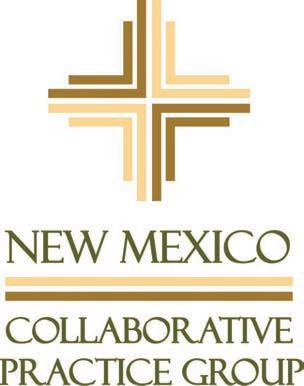
“…Bristol has been an invaluable presence in our movement, demonstrating quiet yet effective leadership that has consistently propelled us forward. His contributions have been instrumental to our success, and his resilience and determination are truly commendable…”
Morgan Honeycutt
Santa Fe Law Group
“…Morgan excels at striking a perfect balance between firmness and fairness when working with both her clients and their spouses. Her skill in advocating for her clients while effectively collaborating with everyone involved is remarkable. Her presence is instrumental in facilitating settlements that truly benefit families...”
“…Her intelligence and collaborative spirit shine through in every interaction, making her not only a skilled advocate but also a trusted partner for her clients. Her honesty and integrity are unwavering, and she approaches her work with a refreshing sense of humor that lightens even the most challenging situations. It is a pleasure to work with her, and she consistently inspires confidence in those around her…”
nmcollabortativedivorce.org

Montgomery & Andrews’ combination with Spencer Fane means our New Mexico team is now backed by a nationwide bench of experienced attorneys representing clients big and small. We’re proud to join a network of more than 540 attorneys from 22 practice groups in 27 offices.
At Spencer Fane, we work to unlock and add value in new and inventive ways. This is our passion; it’s what drives us. Our approach to serving our clients, colleagues, and communities has made us one of the highest-performing firms nationally in workplace satisfaction, client satisfaction, diversity traction, and growth.


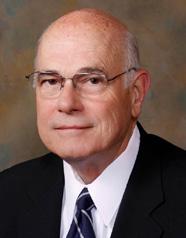






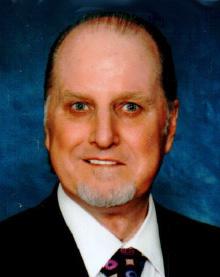













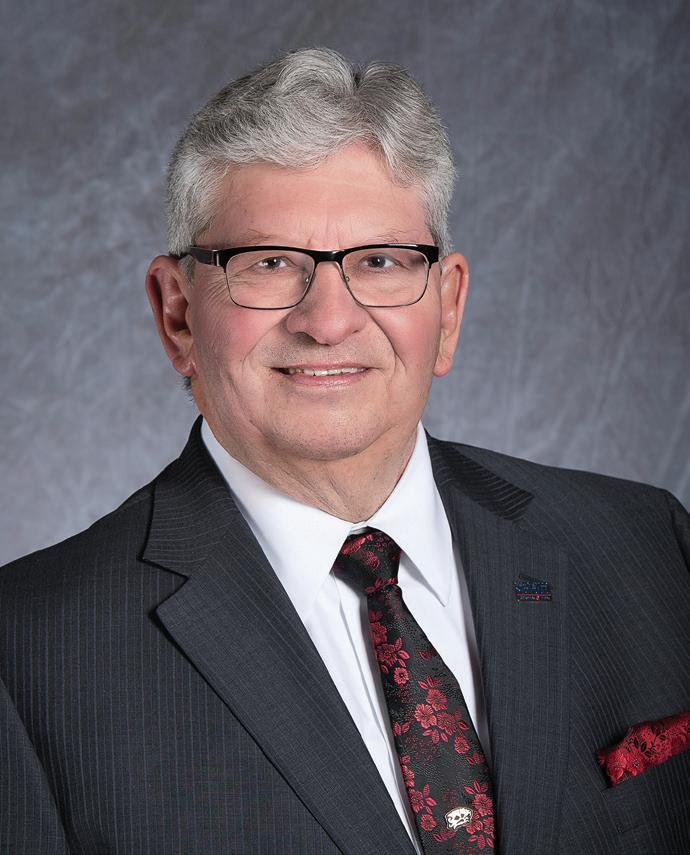










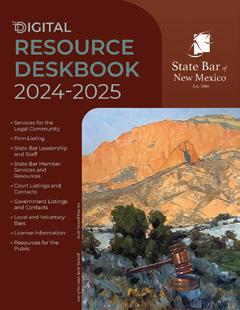
View & Download your FREE digital copy at www.sbnm.org/ Resource-Deskbook-2024-2025 The convenient downloadable digital format will allow you to easily click through the sections of the Resource Deskbook to find the information that you need – whether you are working at your desk or on the go!
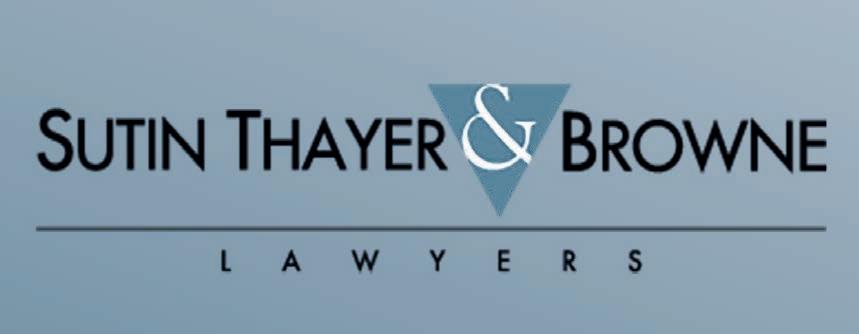


for your conference, seminar, training, mediation, reception, networking event or meeting
Masthead St. NE Albuquerque, NM 87109 www.sbnm.org/StateBarCenter For more information, site visits and reservations, contact Guest Services at 505-797-6070 or roomrental@sbnm.org




The Bar Bulletin publishes twice a month on the second and fourth Wednesday. Advertising submission deadlines are also on Wednesdays, three weeks prior to publishing by 4 pm.
Advertising will be accepted for publication in the Bar Bulletin in accordance with standards and ad rates set by publisher and subject to the availability of space. No guarantees can be given as to advertising publication dates or placement although every effort will be made to comply with publication request. The publisher reserves the right to review and edit ads, to request that an ad be revised prior to publication or to reject any ad. Cancellations must be received by 10 a.m. on Thursday, three weeks prior to publication.
For more advertising information, contact: Marcia C. Ulibarri at 505-797-6058 or email marcia.ulibarri@sbnm.org Get Your Business Noticed! Advertise in our email newsletter, delivered to your inbox every Friday.
• Circulation of 8,000
• Affordable pricing
• High open/click rates
• Schedule flexibility
• Popular content
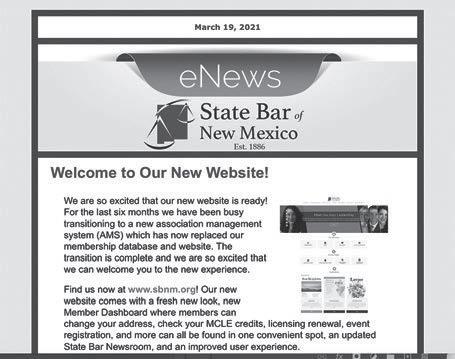
Contact Marcia Ulibarri, at 505-797-6058 or email marcia.ulibarri@sbnm.org




Live! Counseling & Mediation is doing this work and loving it! Also offering
Counseling Parenting Coordination Family Mediation Parent Coaching &
Therapeutic Supervised Visitation
www.livebreatheplay.com
4004 Carlisle Blvd NE, Suite C6, Albuquerque, NM 87107 Ph: 505-717-7227 / info@livebreatheplay.com

Economic Damages Expert Witnesses
William Patterson
Adrianna Patterson
$2,100 flat fee “Gets you to the courthouse steps”. Testimony $1,250/half day. Plaintiff or Defense counsel, proving up your damages case results in fair settlement. www.legaleconomicsllc.com • (505) 242-9812
Are you tired of billable hours? Would you love not to have to go to court? Do you enjoy interacting with and helping people? If you answered yes, then Helpline attorney work may be the perfect fit for you!. The New Mexico State Bar Foundation seeks a fulltime helpline staff attorney for its Modest Means Helpline. Most of the work can be performed remotely from within New Mexico, with occasional mandatory office days. The position includes an excellent benefits package and competitive salary for legal work in the non-profit sector. Full-Time (40 hours/week) Salary: $60,000-$70,000/ year. Duties include providing legal advice and brief legal services over the phone to New Mexico residents who have moderate or low income. Additionally, the attorney will conduct legal workshops and clinics – some remotely and some in-person throughout New Mexico. Applicants must be licensed to practice law in New Mexico, and able to work as part of a busy team in a fast-paced environment. Excellent customer service and computer skills are required. Fluency in Spanish is a plus as is a demonstrable interest in issues affecting the senior community or the lower-income community. Qualified applicants should submit a cover letter and resume to HR@sbnm.org. In your cover letter, please explain why you are interested in working as a helpline attorney. Visit www. sbnm.org/SBNMjobs for full details and application instructions.
Full-Time Transactional Attorney Blackgarden Law is looking for a full-time transactional Attorney with at least 2 years of meaningful experience in Business and Corporate Law. Corporate securities law is a requirement. This is an in-person or hybrid position. Visit our website at blackgardenlaw. com/careers for a full job description and application instructions.
Associate Attorney Civerolo, Gralow & Hill, P.A. seeks an associate attorney to join our fast paced, well established civil litigation defense firm. This is a great opportunity to grow your talent in a collaborative environment. Salary DOE, generous benefits including health, dental & life insurance and 401K match. Please email your resume to custardh@civerolo.com. Inquiries kept confidential.
The Eleventh Judicial District Attorney’s Office, Div. II, in Gallup, New Mexico, McKinley County is seeking applicants for Assistant Trial Attorneys, Trial Attorneys and Senior Trial Attorneys. You will enjoy working in a community with rich culture and history while gaining invaluable experience and making a difference. The McKinley County District Attorney’s Office provides regular courtroom practice, supportive and collegial work environment. You are a short distance away from Albuquerque, Southern parts of Colorado, Farmington, and Arizona. We offer an extremely competitive salary and benefit package. Salary commensurate with experience. These positions are open to all licensed attorneys who are in good standing with the bar within or without the State of New Mexico. Please Submit resume to District Attorney Bernadine Martin, 201 West Hill, Suite 100, Gallup, NM 87301, or e-mail letter to Bmartin@da.state.nm.us. Position to commence immediately and will remain open until filled.
The City of Albuquerque, through the Albuquerque-Bernalillo County Air Quality Control Board (“Air Board”), is seeking a qualified attorney to contract with to provide legal representation and general legal services to the Air Board. This position is an independent contractor, and is not an employee of the City of Albuquerque. Applicant must be admitted to the practice of law by the New Mexico Supreme Court and be an active member of the Bar in good standing. A successful candidate will attend all Air Board meetings, have strong communication skills, knowledge of board governance and Robert’s Rules of Order, the NM Open Meetings Act, and knowledge of environmental rules and regulations including the Clean Air Act. Prior experience with, or advising, boards and commissions is preferred. Please submit a resume to the attention of “Air Board General Counsel Application”; c/o Angela Aragon; Executive Assistant; P.O. Box 2248, Albuquerque, NM 87103 or amaragon@cabq.gov.
Whitener Law Firm, P.A. is seeking a full-time associate attorney to assist with briefing, to attend hearings, depositions, and mediations as well as managing a caseload of personal injury cases. Candidates must be highly motivated, client oriented and enjoy working in a fast-paced environment. Candidates must be licensed to practice in the state of New Mexico. Must have at least five years of experience. Salary competitive and commensurate to experience and qualifications. Please send resume to Leanne Duree, Whitener Law Firm, P.A., 4110 Cutler Avenue, N.E., Albuquerque, NM 87110, fax to 505-242-3322 or e-mail to leanne@ whitenerlawfirm.com.
Assistant Trial Attorney or Trial Attorney wanted for immediate employment with the Seventh Judicial District Attorney’s Office, which includes Catron, Sierra, Socorro and Torrance counties. Employment will be based primarily in Sierra County (Truth or Consequences, NM). T or C is approximately a one hour commute from Las Cruces. Must be admitted to the New Mexico State Bar. Salary range will be $72,301 - $90,377 and commensurate with experience and budget availability. Will also have full benefits and one of the best retirement plans (PERA) in the country. Send resume to: Seventh District Attorney’s Office, Attention: J.B. Mauldin, P.O. Box 1099, 302 Park Street, Socorro, New Mexico 87801. Or email to: jbmauldin@ da.state.nm.us .
Description: Rodey, Dickason, Sloan, Akin & Robb, P.A. is currently seeking attorneys with Civil Litigation experience to work in our Albuquerque office. Qualifications: Ideal candidate must have strong academic credentials, excellent references, solid writing skills, deposition experience, hearing experience, and must be licensed in New Mexico. Experience in professional liability, medical negligence or personal injury is preferred. Candidates should possess the desire to work as a team, to mature their legal skills, and to represent their clients well. Rodey offers comprehensive benefits package, including health, dental and vision; professional development and multi-faceted mentoring program; FSA and HSA plan option(s); 401K plan/employer match; group life and longterm disability insurance; employee assistance program; wireless phone/services stipend. We are excited about our opportunity to partner with qualified candidates looking to advance their legal career. For consideration, please include a cover letter, resume, law school transcript and writing sample and submit via email to Ali Dyer, Human Resources Director at: jobs@rodey.com with “Litigation Attorney” in the subject line. All inquiries will be kept confidential. Rodey is an Equal Opportunity Employer. Rodey Law Firm is not accepting unsolicited resumes from search firms for this position.
Assistant Trial Attorney or Trial Attorney wanted for immediate employment with the Seventh Judicial District Attorney’s Office, which includes Catron, Sierra, Socorro and Torrance counties. Employment will be based primarily in Socorro County (Socorro, NM). Socorro is approximately a one hour commute from Albuquerque. Must be admitted to the New Mexico State Bar. Salary range will be $72,301 - $90,377 and commensurate with experience and budget availability. Will also have full benefits and one of the best retirement plans (PERA) in the country. Send resume to: Seventh District Attorney’s Office, Attention: J.B. Mauldin, P.O. Box 1099, 302 Park Street, Socorro, New Mexico 87801. Or email to: jbmauldin@ da.state.nm.us .
MDZ Legal Group, In-house counsel for Loya Insurance Group, has openings for associate attorneys with 0-5 years of experience. We offer a collegial office environment; a good work / life balance, and many excellent employment benefits. Our Albuquerque office is growing and offering a competitive salary as well. Please send your resume to: Ulibarri@ mdzlegalgroup.law.
– Civil Litigation
Join Sutin, Thayer & Browne where you can grow your legal practice and thrive while having flexibility and support! We have been New Mexico’s trusted choice for legal services for over 75 years and we’re seeking to energize the traditional big law firm model. You’ll be part of a supportive team where excellence meets a vibrant workplace culture. Our teams handle everything from business transactions to litigation with a unique, client-focused approach and a collaborative spirit that sets us apart. Here’s what we offer: competitive compensation structure, flexible remote work, and opportunities for growth and mentorship. We have a fantastic benefits package including medical, dental, and vision insurance, 401(k) matching, profit sharing, and employer-paid life and long-term disability insurance. Join us and dive into diverse areas of law while looking forward to one day leading a team. Ready to grow with us? Let’s make it happen! We are looking to hire a full-time Attorney with at least 4-5 years of relevant experience to join our Litigation practice. A book of business is NOT required. Interest in commercial and governmental law is a plus. To apply, please send please send a letter of interest, résumé, and writing sample to both: Eduardo Duffy, Recruiting Chair, at EAD@sutinfirm.com and Danielle Smith, HR Manager, at DSS@ sutinfirm.com
The Carrillo Law Firm, P.C., located in Las Cruces, NM, is seeking an Attorney to join the firm. The firm handles complex litigation as well as day-to-day legal matters from government and private clients. Applicant must have a current license to practice law in New Mexico, and possess strong legal research and writing skills, have a positive attitude, strong work ethic, and desire to learn. We offer competitive benefits to include health insurance, profit sharing plan, and an excellent work environment. Please send letter of interest, resume, references, and writing sample via email to deena@carrillolaw.org. All responses are kept confidential.
Busy Plaintiff's civil litigation firm located near the Journal Center is accepting resumes for an associate attorney with 5 (or more) years of practical experience. Candidates should possess strong oration skills, be proficient in conducting and defending depositions, have critical research and writing abilities and be familiar with motion practice. Practice areas include civil litigation/personal injury and general tort issues. Litigation experience preferred, but will not bar consideration. Salary commensurate with experience. Please forward a letter of interest along with a Resume and writing sample to:paralegal3.bleuslaw@gmail.com.
The Eleventh Judicial District Attorney’s Office, Div. II, in Gallup, New Mexico, McKinley County is seeking applicants for a Contract Prosecutor to assist in the prosecution of criminal misdemeanor cases, felony cases and conflict of interest cases. The Contract Prosecutor position requires substantial knowledge and experience in criminal prosecution, rules of evidence and rules of criminal procedure; trial skills; the ability to draft legal documents and to research/analyze information and situations and the ability to work effectively with other criminal justice agencies and Law Enforcement. This position is open to all attorneys who have knowledge in criminal law and who are in good standing with the New Mexico Bar. Limited License is okay. Salary will result in a contractual agreement between the contract prosecutor and the District Attorney. Submit letter of interest and resume to District Attorney Bernadine Martin, 201 West Hill, Suite 100, Gallup, NM 87301, or e-mail letter to bmartin@da.state.nm.us.
Atkinson, Baker & Rodriguez, P.C. is a successful and established Albuquerquebased complex civil commercial and tort litigation firm seeking motivated and talented associate attorney candidates with great academic credentials. Join our small but growing focused Firm and participate in litigating cases from beginning to end with the support of our nationally recognized, experienced attorneys! Come work for a team that fosters development and growth to become a stand-out civil litigator. Highly competitive compensation and benefits. Send resumes, references, writing samples, and law school transcripts to Atkinson, Baker & Rodriguez, P.C., 201 Third Street NW, Suite 1850, Albuquerque, NM 87102 or. Please reference Attorney Recruiting.
The Thirteenth Judicial District Attorney’s Office is seeking both entry level and experienced attorneys. Positions available in Sandoval, Valencia, and Cibola Counties. Enjoy the convenience of working near a metropolitan area while gaining valuable trial experience in a smaller office, providing the opportunity to advance more quickly than is afforded in larger offices. The 13th Judicial District offers flex schedules in a family friendly environment. Competitive salary starting @ 83,000+ depending on experience. Contact Krissy Fajardo @ kfajardo@da.state. nm.us or visit our website for an application @ https://www.13th.nmdas.com/ Apply as soon as possible. These positions fill fast!
Tired of billable hours? The Law Offices of Erika E. Anderson is seeking a highly motivated attorney. The law firm is a very busy and fast-paced AV rated firm that specializes in civil litigation on behalf of Plaintiffs. We also do Estate Planning and Probate litigation. The candidate must be well organized, pay close attention to detail, be willing to take on multiple responsibilities, and be highly skilled when it comes to both legal research and writing. This is a wonderful opportunity to join an incredible team that works hard and is rewarded for hard work! The position offers a supportive and collaborative work environment, a competitive salary, and a generous benefits package. If interested, please send a resume to accounting@eandersonlaw.com.
The New Mexico Center on Law and Poverty seeks a full-time attorney to join our Public Benefits team to address hunger and improve public assistance programs for children and families, including SNAP, TANF, childcare assistance, Medicaid, and other programs. Attorneys provide systemic advocacy through legal representation, impact litigation, administrative advocacy, policy and legislative advocacy, and community outreach and coalition-building. Required: 2 or more years experience (7+ years for senior attorneys), and a strong commitment to economic and racial justice. See the full description at: www.nmpovertylaw.org/ careers-and-internships. Apply in confidence by emailing your resume and a cover letter describing what interests you about NMCLP’s mission to contact@nmpovertylaw.org.
NO BILLABLE HOURS! STUDENT LOAN FORGIVENESS! ELEVEN PAID HOLIDAYS! The Child Support Services Division (CSSD) of the New Mexico Health Care Authority (previously the Human Services Department) is HIRING entry level and experienced attorneys to work in the Las Cruces, Los Lunas, Clovis, or Roswell offices. Salary is based on SPO’s NEW pay bands (LH) with a midpoint of $108,296.00, that is adjusted depending upon experience. CSSD offers fitness and wellness leave (2 hours/week) and alternative work schedules once you have completed probation. Newly licensed attorneys or those wishing to relocate to New Mexico are encouraged to apply. Apply online: State Personnel Office (https://careers.share.nm.gov), or contact Reina Owen DeMartino at Reina. OwenDeMartino@hca.nm.gov.
The Fifth Judicial District Attorney’s office has immediate positions open for new and/ or experienced attorneys. Salary will be based upon the New Mexico District Attorney’s Salary Schedule with salary range of an Assistant Trial Attorney ( $ 72,301.00 ) to a Senior Trial Attorney ( $85,222.00), based upon experience. Must be licensed in the United States. These positions are located in the Carlsbad and Roswell, NM office. The office will pay for your New Mexico Bar Dues as well as the National District Attorney’s Association membership. Please send resume to Dianna Luce, District Attorney, 102 N. Canal, Suite 200, Carlsbad, NM 88220 or email to nshreve@da.state.nm.us
New Mexico Legal Aid (NMLA) provides civil legal services to low income New Mexicans for a variety of legal issues including domestic violence/family law, consumer protection, housing, tax issues and benefits. NMLA has locations throughout the state including Albuquerque, Santa Fe, Las Cruces, Gallup, Roswell, Silver City, Clovis, Hobbs, Las Vegas, Taos, and Santa Ana. Managing Attorney: Multiple positions; Staff Attorney Positions: Multiple positions; Paralegal: Multiple positions. Please visit our website for all current openings, NMLA benefits, Salary Scales and instructions on how to apply - https:// newmexicolegalaid.isolvedhire.com/jobs/
The New Mexico Center on Law and Poverty seeks a full-time attorney to advance housing and consumer rights for New Mexico’s families. Attorneys provide systemic advocacy through legal representation, impact litigation, administrative advocacy, policy and legislative advocacy, and community outreach and coalition-building. Required: 1+ years experience and a strong commitment to economic and racial justice. See the full description at: www.nmpovertylaw.org/ careers-and-internships. Apply in confidence by emailing your resume and a cover letter describing what interests you about NMCLP’s mission to contact@nmpovertylaw.org.
Pueblo of Laguna, NM – Great employer and benefits, competitive pay DOE! Seeking full-time attorney to provide legal advice and representation to Laguna members on broad range of civil matters, including consumer, probate, benefits, and family issues. Leisurely commute from Albuquerque metro or Grants, and partial remote-work available. Apply now, open until filled. Application instructions and position details at: https://www.lagunapueblo-nsn.gov/ elected-officials/secretarys-office/humanresources/employment/
The City of Albuquerque Legal Department is hiring for various Assistant City Attorney positions. Hybrid in person/remote work schedule available. The Legal Department’s attorneys provide a broad range of legal services to the City and represent it in legal proceedings in court and before state, federal and administrative bodies. Current open positions include: Labor/ Employment Attorney: The City is seeking an attorney to represent it in litigation related to employment and labor law in New Mexico State and Federal Courts, before the City of Albuquerque Personnel Board, and before the City of Albuquerque Labor Board; General Counsel: The City is seeking attorneys to provide a broad range of general counsel legal services to various City departments, boards, commissions, and agencies in the Municipal Affairs and Real Estate and Operations divisions. Responsibilities include, but are not limited to, drafting legal opinions, reviewing and drafting ordinances and executive/ administrative instructions, reviewing and drafting contracts, and providing general advice and counsel on day-to-day operations for various Departments throughout the City; Land Use and Enforcement Division: The City is seeking an attorney to enforce traffic violations and provide general counsel support to various Departments and programs, including, but not limited to, Animal Welfare and automated speed enforcement; Air Quality Attorney: The City is seeking an attorney for the Real Estate and Operations Division. This attorney will serve as general counsel to the City’s Environmental Health Department (“EHD”) regarding Air Quality issues throughout Bernalillo County including at federal and state facilities. This attorney will provide a broad range of legal services to EHD including, but not limited to, administrative enforcement actions, litigation and appeals, stationary source permits and "fugitive dust" permits, air quality monitoring and quality assurance, guidance regarding EPA grants, control strategies, work with EHD teams to develop new or amended regulations to be proposed to the Albuquerque-Bernalillo County Air Quality Control Board (“Air Board”), attend and represent EHD staff at rulemaking and adjudicatory hearings, review and draft intergovernmental agreements regarding air quality issues, review and draft legislation regarding air quality; General Counsel to APD: The City is seeking an attorney to advise APD regarding policies, procedures and training, review and negotiate contracts, review uses of force, draft legal opinions, review and draft legislation and administrative instructions. Additional duties may be assigned based on experience; Utilities/PRC: The City is seeking an attorney to represent it in
matters regarding franchise and right of way agreements, public utilities, broadband and telecommunications, and will appear before the Public Regulation Commission (“PRC”). Attention to detail and strong writing and interpersonal skills are essential. Preferences include: experience with litigation, contract drafting and review, government agencies, government compliance, and policy writing. Salary based upon experience. For more information or to apply please send a resume and writing sample to Angela Aragon at amaragon@cabq.gov.
The New Mexico Prison & Jail Project (NMPJP) is a nonprofit legal organization that advocates to protect the rights of incarcerated people in New Mexico by bringing civil rights lawsuits and other legal actions on their behalf. NMPJP has an open position for a full-time staff attorney. Generous benefits package. Salary dependent on experience. The ideal candidate will have a passion for advocating for the rights of people who are incarcerated and significant experience with federal and/or state litigation. We also seek candidates with a proficiency in legal research and document drafting; and excellent written, verbal and interpersonal communication skills. Email a letter of interest, resume and legal writing sample by December 1, 2024 to the selection committee at info@nmpjp.org.
Ashton Horton Mullins PC provides comprehensive estate planning services to our clients. We pride ourselves on our commitment to excellence and our personalized approach to each client. We are seeking a motivated and detail-oriented Associate Attorney to join our estate planning team. Experience in estate planning is not required as we are looking to grow our team with an attorney who has the desire to learn estate planning and we will provide structured mentorship and training. Key responsibilities that will increase with mentorship and training: Draft wills, trusts, and other estate planning documents; Advise clients on estate planning strategies and tax implications; Conduct client meetings and maintain strong client relationships; Collaborate with senior attorneys on complex cases. What we offer: Competitive salary and benefits package; Opportunities for professional development and growth; Supportive and collaborative work environment; Position in Albuquerque or Santa Fe with flexibility on hybrid work. Please submit your resume, cover letter, and a writing sample to bridget@ ahm.law. We look forward to hearing from you! Ashton Horton Mullins PC is an equal opportunity employer. We celebrate diversity and are committed to creating an inclusive environment for all employees.
Appellate boutique Durham, Pittard & Spalding LLP is looking for bright, motivated, and talented lawyers to join our growing and successful team in our office in Santa Fe. Our firm specializes in civil appeals and provides trial support to some of the best trial lawyers in New Mexico and throughout the country in high-stakes, complex litigation on behalf of plaintiffs. Our practice is heavily focused on catastrophic injury and wrongful death litigation, including product liability, toxic tort, medical malpractice, and trucking, but our attorneys also handle a wide variety of other civil matters including civil rights, employment, and the occasional domestic relations or criminal appeal. We are looking for candidates who enjoy researching, writing, and presenting oral argument to trial and appellate courts. The position offers the opportunity to learn from experienced practitioners and to develop the skills of a top-notch appellate attorney. If interested, please send a cover letter, resume, and writing sample to: jkaufman@dpslawgroup.com.
The New Mexico State Bar Foundation seeks qualified applicants to join our team as a fulltime (40 hours/week) Bilingual Telephone Helpline Intake Screener. The successful applicant will answer Bar Foundation Legal Helplines incoming calls, conduct/complete intakes and establish case files in the Legal Services Programs electronic case management systems. Fluency in Spanish is required. $17$19/hour, depending on experience and qualifications. Generous benefits package included. This position qualifies for partial telecommuting. Qualified applicants should submit a cover letter and resume to HR@sbnm. org. Visit www.sbnm.org/SBNMjobs for full details and application instructions.
Paralegal position in established commercial civil litigation firm. Prior experience preferred. Requires knowledge of State and Federal District Court rules and filing procedures; factual and legal online research; trial preparation; case management and processing of documents including acquisition, review, summarizing, indexing, distribution and organization of same; drafting discovery and related pleadings; maintaining and monitoring docketing calendars; oral and written communications with clients, counsel, and other case contacts; proficient in MS Office Suite, AdobePro, Powerpoint and adept at learning and use of electronic databases and legal software technology. Must be organized and detailoriented professional with excellent computer skills. All inquiries confidential. Salary DOE. Competitive benefits. Email resumes to or Fax to 505-764-8374.
Conklin, Woodcock, Ziegler & Hazlett, P.C, a medium-sized downtown litigation firm is accepting resumes for a full-time legal assistant position. We are seeking a motivated, team-orientated person with experience in civil litigation, court rules and filing procedures. There may be some opportunity for paralegal work as well. Candidates must have solid clerical, organizational, computer and word processing skills. Excellent benefits, including 401K, health insurance benefits, paid vacation and sick leave, as well as yearend bonus opportunities. Salary will be based on experience and skills. Please respond to this ad with your resume and references to jobs@conklinfirm.com.
The UNM Office of University Counsel is looking for a paralegal to support its Health Sciences Center. This is an opportunity to work in a fast-paced environment with the medical malpractice defense team as they support the providers and staff of New Mexico’s only Academic Medical Center and Level One Trauma Center. As the employer of choice in New Mexico, UNM offers a robust benefits package and a commitment to work/ life balance. To apply, please submit a cover letter, resume, and application via UNM jobs at https://unmjobs.unm.edu, req31398. Please apply as soon as possible.
Stiff, Garcia & Associates, defense insurance firm seeking full time, experienced associate eager to work and motivated. Must have 3 + years of experience. Benefits included, Health, Dental, 401K, LTD & Life Ins. Salary ranges from $85,000 to $120,000.00. Please send resume to John Stiff at jstiff@stifflaw.com or Karen Arrants at karrants@stifflaw.com
The Carrillo Law Firm, P.C. is seeking a selfmotivated, full-time litigation paralegal for their busy Las Cruces, New Mexico practice. The firm’s practice areas include civil litigation, employment and labor law, civil rights defense, and insurance litigation. Candidate must possess knowledge of local rules and court filing procedures, have excellent writing and proofreading skills and communication and organizational skills, and be proficient with Microsoft Word, Excel, and Outlook. A degree or paralegal certification is preferred, but we will consider experience in lieu of education. Competitive salary and benefits offered. All inquiries are kept confidential. Please email cover letter, resume, and references to deena@ carrillolaw.org.
Madison, Mroz, Steinman, Kenny & Olexy, P.A., a well-established civil litigation firm, seeks a full-time Legal Assistant/ Legal Secretary. The ideal candidate should have a minimum of 5 years civil litigation experience, with preference towards medical malpractice, the ability to multitask effectively in a fast-paced environment, possess excellent skills in case management and calendar procedures, ability to assess priorities, highly motivated, detail oriented, strong work ethic, knowledge of State and Federal court rules, and proficient in Odyssey and CM/ECF e-filing. We offer an excellent fully funded health insurance plan, 401(K) and Profit Sharing Plan, paid designated holidays, PTO, and a professional and teamoriented environment. Please submit your resume to: becky@madisonlaw.com, or mail to Office Administrator, P.O. Box 25467, Albuquerque, NM 87125-5467.
Office Administrator and Bookkeeper for Small
Experienced office administrator offering part-time support for small or solo law practices. Available services include: Accounts Payable & Receivable, Payroll processing and Quarterly Payroll Reports through QuickBooks, Gross Receipts Taxes, Bank Account reconciliations, Vendor negotiations, Property management, Client billing, Benefits administration, Executive support (calendar management, travel arrangements, meeting coordination), General office management and support. Available for either remote or on-site work. Contact me to discuss how I can assist your firm. References available upon request. Call or text Laura at (505) 480-6979.
Two Santa Fe Offices Available January 1,2025
Two adjacent offices in a six-office professional suite. Centrally located in The Saint Francis Professional Center, the suite has a large reception area, kitchenette, and ample parking for clients. Rent includes alarm, utilities, and janitorial services. $975 mo/ both 505-795-0077
Walking distance to Metro, District and Federal Court. 511 Marble NW. Albuquerque, New Mexico, 87102. Contact Ross Sanchez @ 505 400 7482
Office Suites Available
Locally owned and operated. Move-in ready suites (155 sq ft & 350 sq-ft) ideal for a solo attorney. Conveniently located in the North Valley with easy access to I-25, Paseo Del Norte, and Montano. Visit our website www. sunvalleyabq.com for more details or call Jaclyn Armijo at 505-343-2016.
Office Alternatives, locally owned circa 2006, has Executive Office Suites, Virtual mail/ professional address, Virtual receptionist service, hourly offices and conference room rentals, Witness and Notary services. OA provides the infrastructure for attorney practices to lower your overhead and work in a professional environment. 2 convenient locations-Journal Center and Riverside Plaza. 505-796-9600 www.officealternatives.com.
Updated 2,877 square foot law office building in the Sawmill District with 5 offices, secretarial area, library/conference room, file room, and 15 parking spaces. Vaulted ceilings, refrigerated cooling/heating, and kitchenette. Handicap accessible Men and Women’s Restroom. Call Keith Bandoni at 505-880-7015.
Will of David Paul Powers: If you possess or have information about a Will for David Paul Powers, formerly of Lindrith and Albuquerque, NM, please contact Jerry Powers, 15 Blanco Dr. Edgewood NM 87015, or telephone 505-321-6161.
Attorney Fred C. Martinez, at 1201 Lomas Blvd., NW Ste. B, Albuquerque, NM 87102, phone number, (505) 242-1310, email address, martinezfredc@gmail.com, is searching for a Last Will and Testament for Mr. Michael Anthony Leal, Deceased, born on the 28th day of June 1948 and died on or about the 19th day of December 2023, in Estancia, Torrance County, New Mexico. Any-one having any information about the Last Will and Testament and/or a trust prepared for Mr. Michael Leal, Deceased, or any probate related proceedings concerning Mr. Michael Anthony Leal, please contact Fred C. Martinez, Attorney at Law at (505) 242-1310 or by email at martinezfredc@gmail.com.









